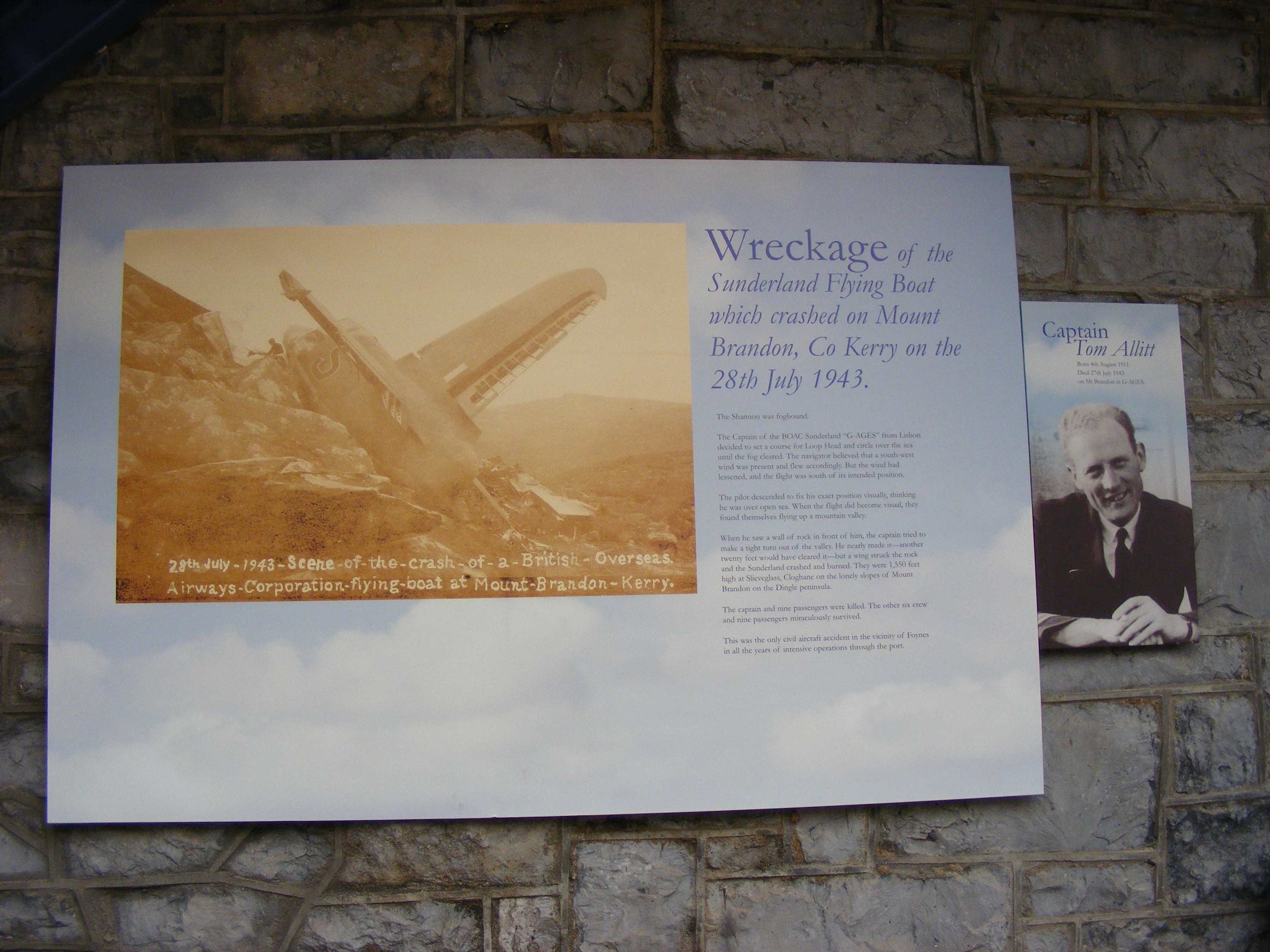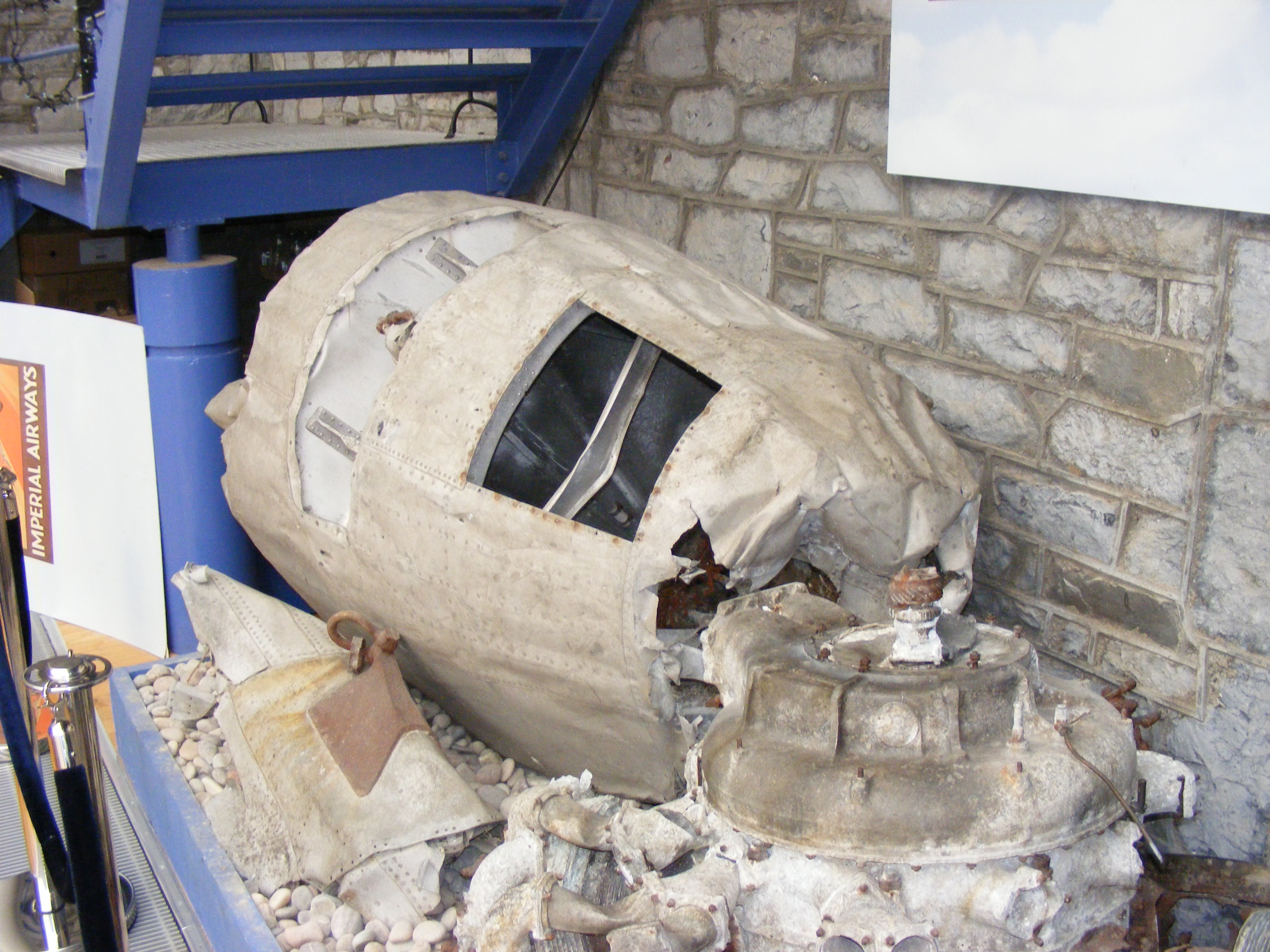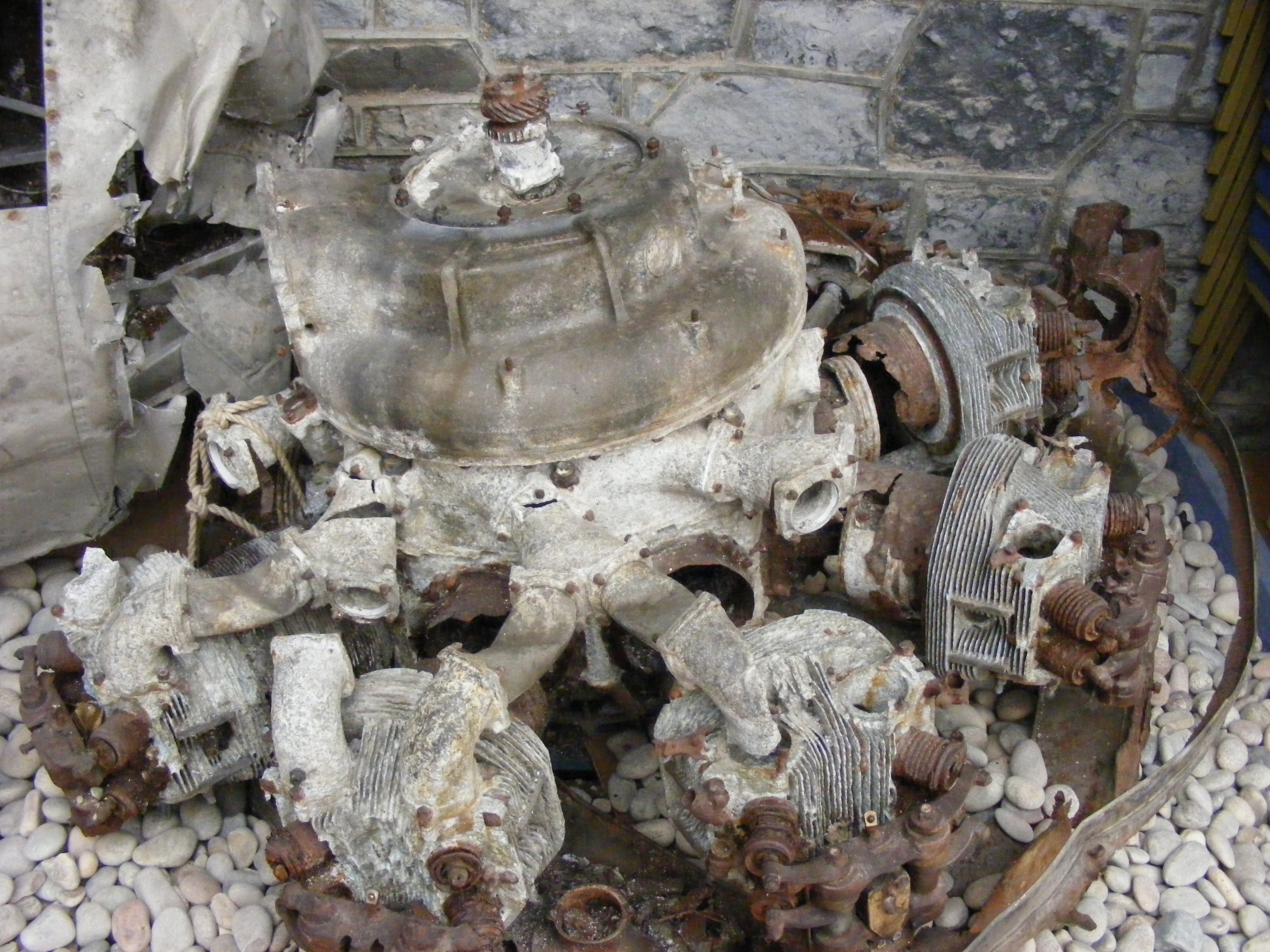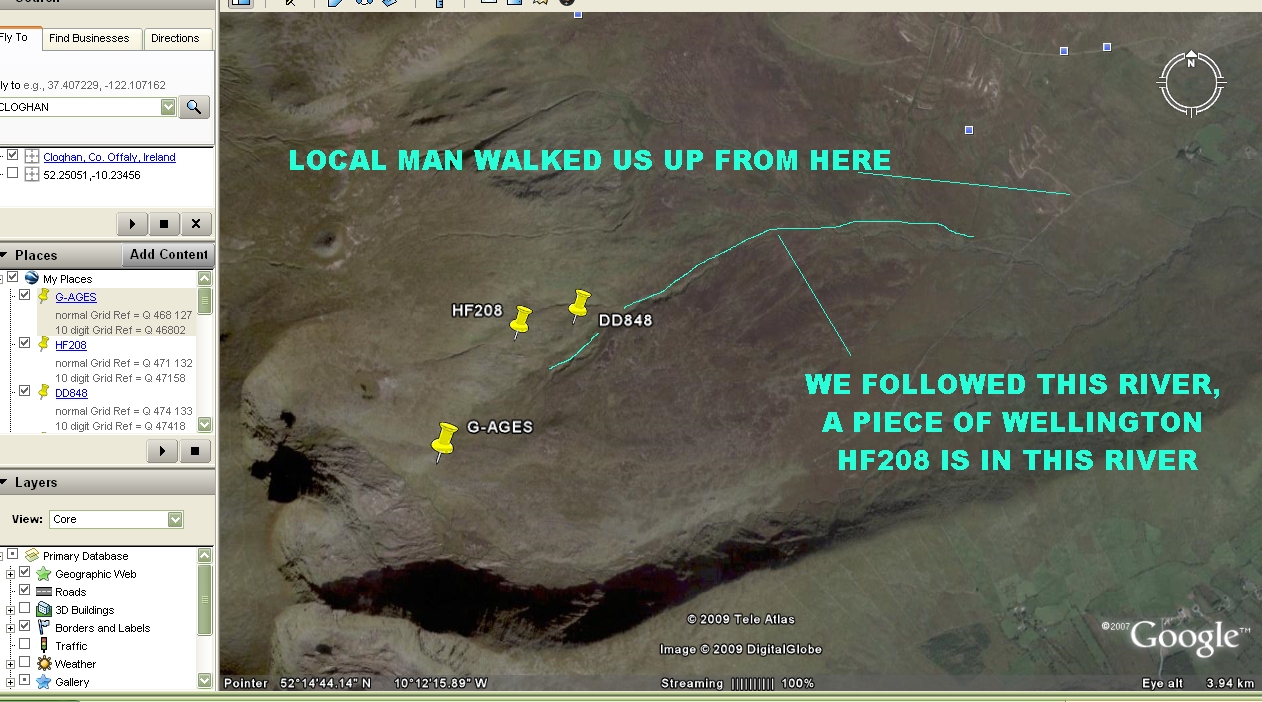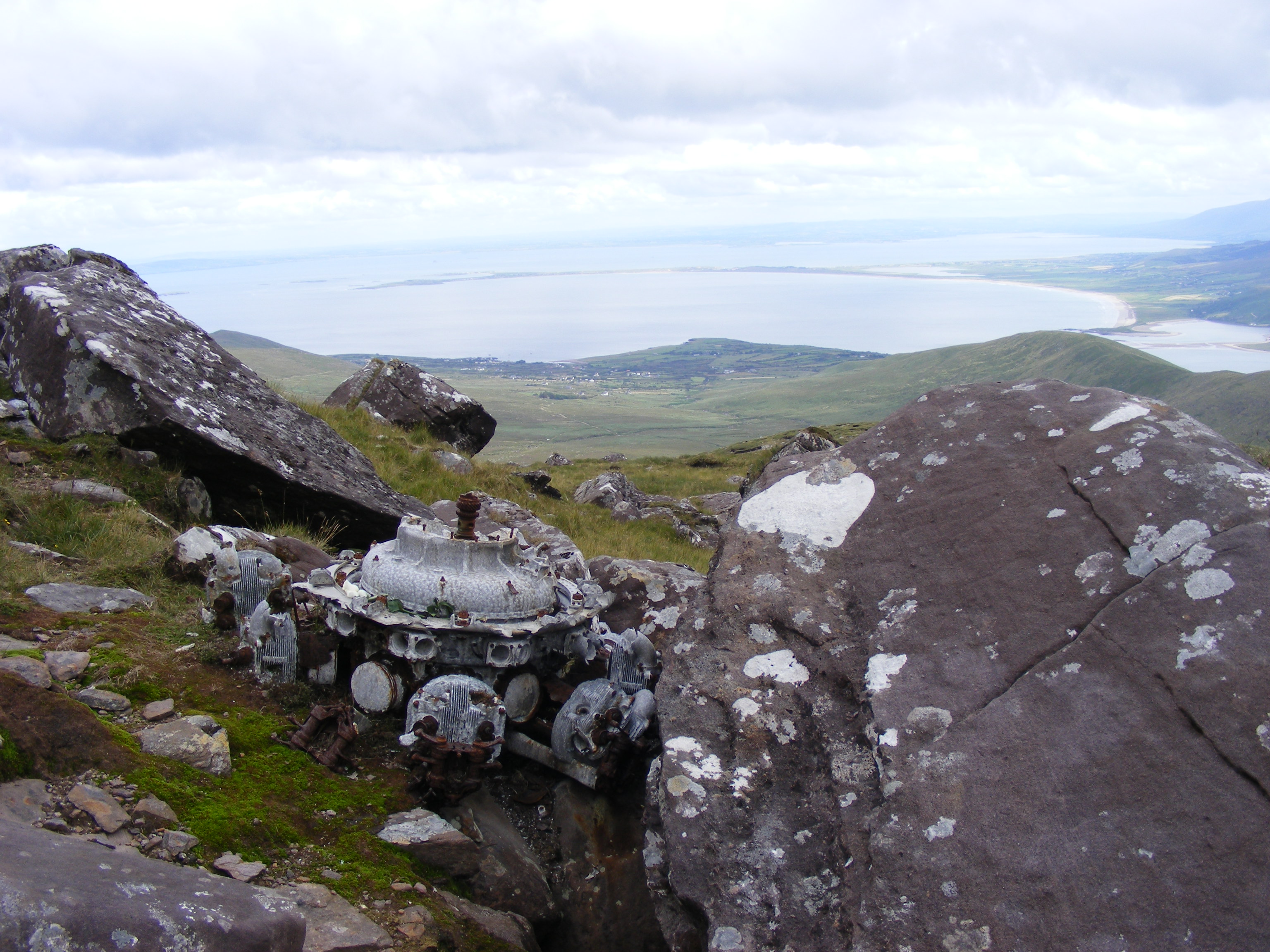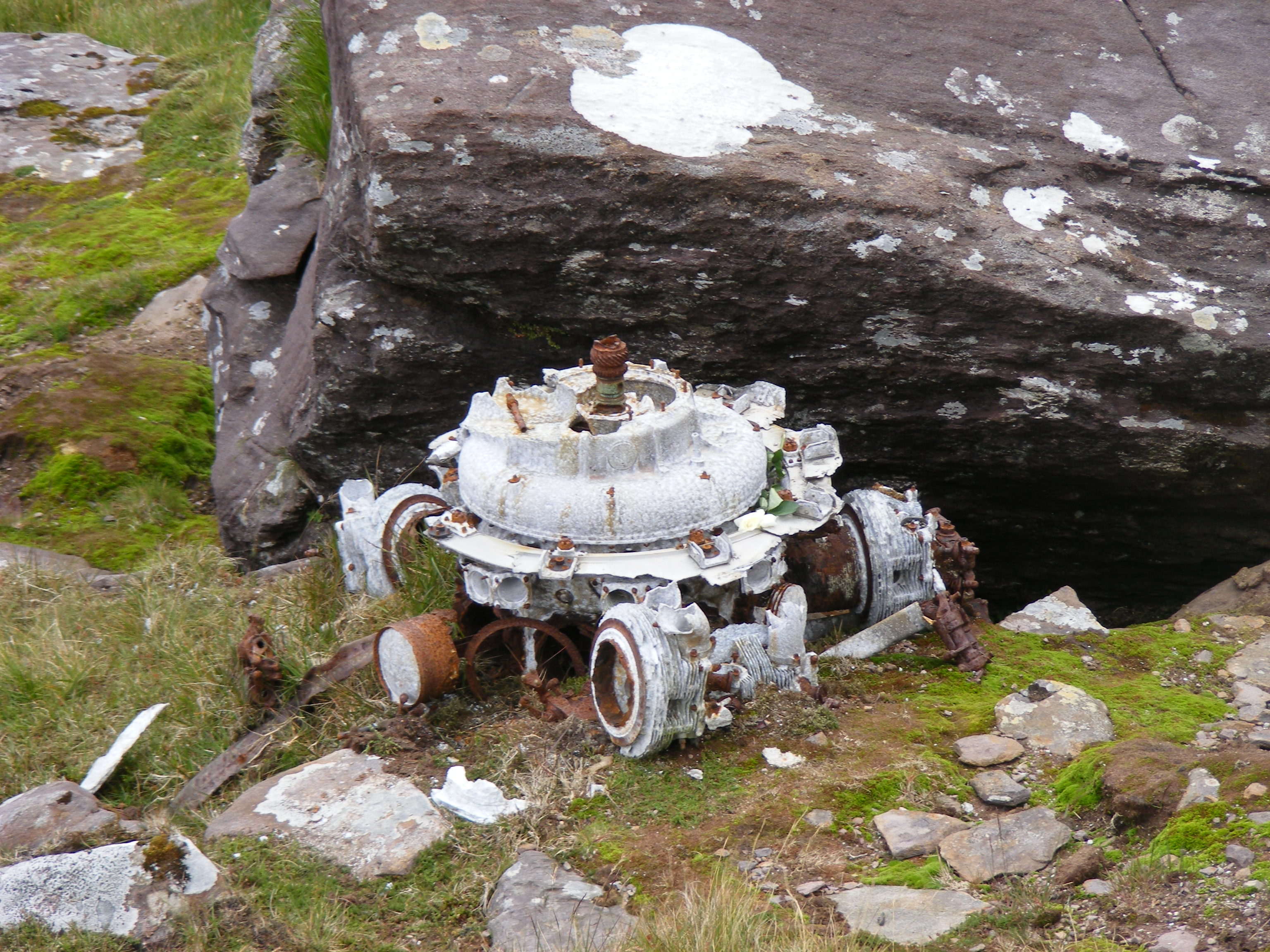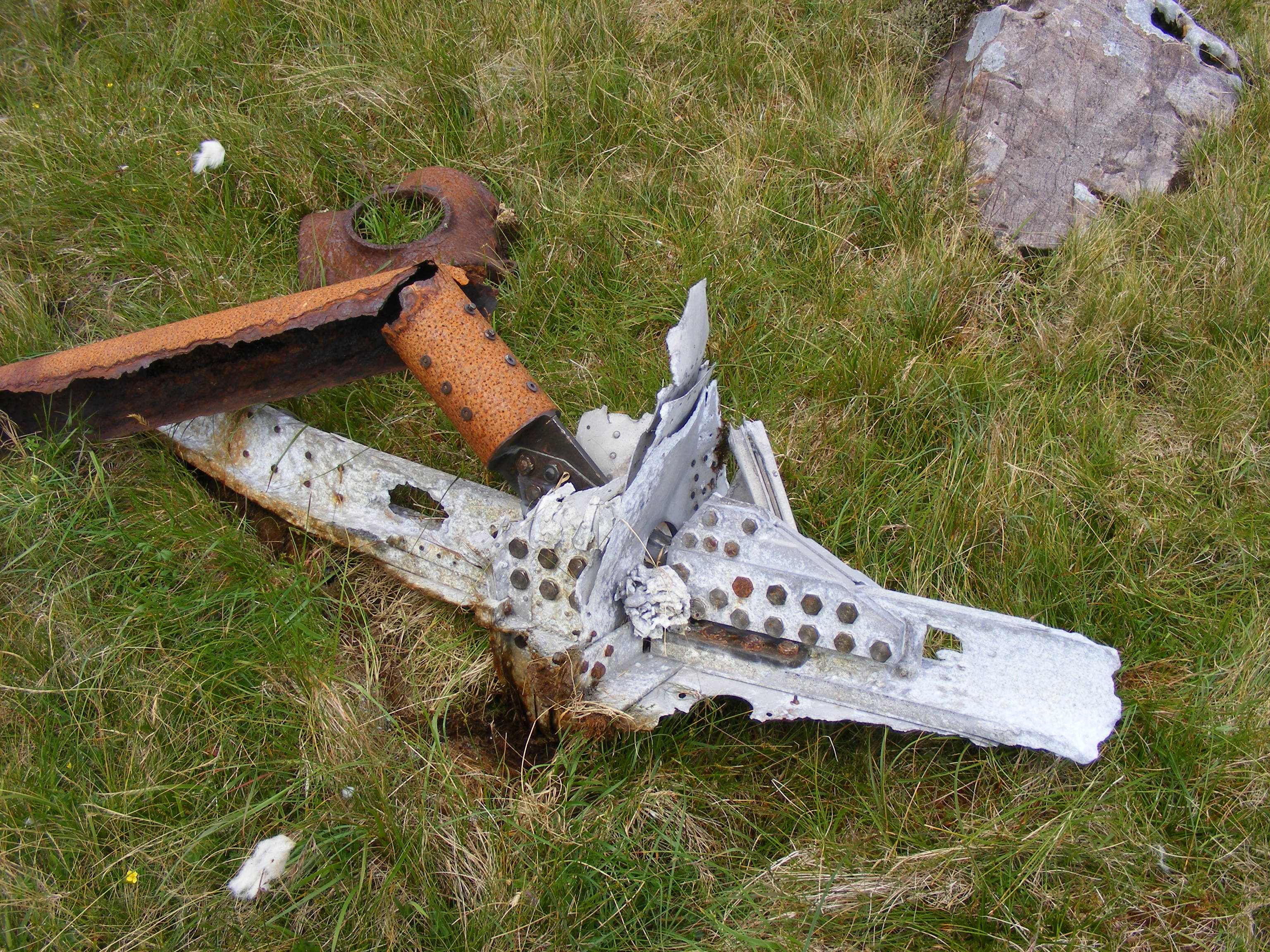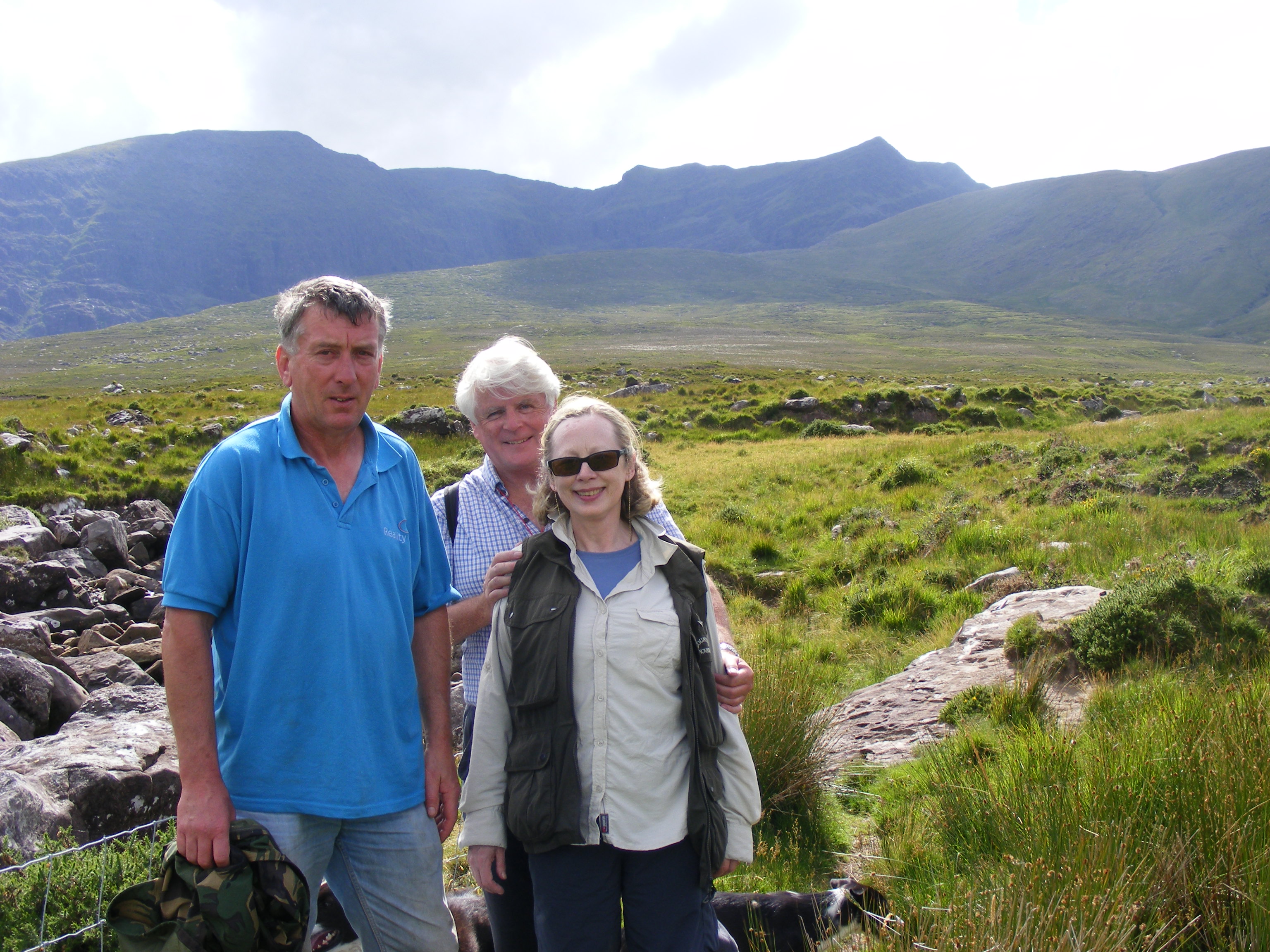Shorts Sunderland G-AGES, British Overseas Airways Corporations
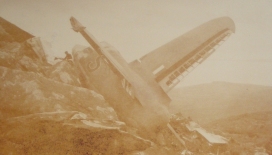 On the morning of
July 28th 1943, the BOAC flight from Lisbon in Portugal to
Foynes in Ireland crashed into the slopes of Mount Brandon in
County Kerry. Of the 25 men on board, 10 lost their lives and
the remaining 15 crew and passengers suffered injuries. The
story of the 25 men on Sunderland G-AGES is told below.
On the morning of
July 28th 1943, the BOAC flight from Lisbon in Portugal to
Foynes in Ireland crashed into the slopes of Mount Brandon in
County Kerry. Of the 25 men on board, 10 lost their lives and
the remaining 15 crew and passengers suffered injuries. The
story of the 25 men on Sunderland G-AGES is told below.
If you are related to or have any extra information,
especially a photo of any of the men listed below I would be
very grateful if you could contact me to help complete the
record for this aircraft. June 2025
That morning of July 28th, the crew and passengers of the British Overseas Airways Corporation (B.O.A.C.) Sunderland flight from Lisbon, Portugal, to Foynes outside Limerick, Ireland would crash into the mountain in fog, killing 10 of those on board. The flight, with a crew of seven and eighteen passengers had left Lisbon late in the evening before and made its way up across the Atlantic. The passengers were a mix of civilian and military personnel. Eight men were airmen returning from temporary internment in neutral Portugal. Other military personnel were returning from postings in Africa and one was recuperating from injuries received in East Africa. The civilians on board were on official business for their governments.
Due to the weather and light conditions around the Foynes area when the aircraft, Sunderland G-AGES, arrived overhead, the captain of the aircraft elected to fly back out to sea for a period of time to await more favorable conditions for the aircraft to land in.
They had arrived somewhat ahead of their planned time and it was while they were flying away from the Foynes base that the aircraft crashed into the mountain. Of those on board, ten men would loose their lives while the remainder would all suffer injuries of some manner.
The flying boat museum at Foynes outside Limerick displays the
remains of one of the aircraft's engines, a wing tip float and
other wreckage. (See below)
Contents
1. Location of the crash.
2. Crew and Passengers on
Board
3. Passengers - Origin (From AVIA 2314) Lagos
Africa
4. Commonwealth War Graves Commission Entries
- www.cwgc.org
5. Aircraft History
6. Foynes Museum Displays
7. Summary of the Official B.O.A.C. Enquiry
Report
8. Incident Report of the Irish Department of
Industry and Commerce.
9. Media Reports from Contemporary Newspapers
and Magazines
10. The Aircrew who were interned in
Portugal.
11. Notes from Irish Army Reports SI314 and
G2/X/1216
12. Notes from Swiss Foreign Office
(DFAE)
13. Promotions notes for RAF officers from
London Gazette
14. Other wartime fatalities in the Mount
Brandon area.
1. Location of the crash.
The aircraft impacted the top of sloping ground, rising south
westerly, and just to the north east of Mount Brandon, on the
Dingle peninsula. The arrow depicts the general direction
of travel.

The photos displayed in the album viewer below show, in images
1 - 5, some of the artifacts in the Foynes Flying Boat Museum,
and in images 6 to 11, are images taken in 2008 during Tom
Allitt's daughter hike to the crash site.
Crew and Passengers on Board
Thomas ALLITT - Captain
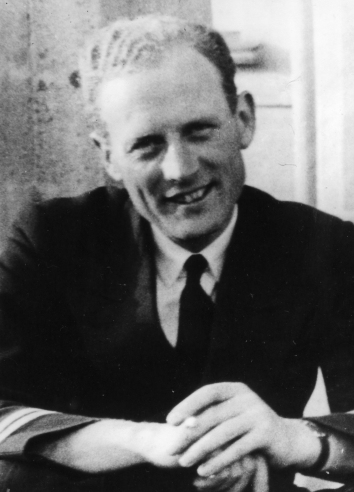 Tom Allitt was
aged 32, the son of William and Harriet Allitt; husband of
Margaret Mary Allitt, of 14A Walton Park, Liverpool.
He came originally from Flint, in north Wales, his mother dying
when he was only seven years old.
Tom Allitt was
aged 32, the son of William and Harriet Allitt; husband of
Margaret Mary Allitt, of 14A Walton Park, Liverpool.
He came originally from Flint, in north Wales, his mother dying
when he was only seven years old.
Thomas enlisted in the RAF in 1927 as an apprentice. He
was cleared for flying training in 1932, going on to be a
Sergeant by 1938 when he was discharged from the RAF at own
request to work as a first officer with Imperial Airways.
He entered the RAFVR in 1939 and was put forward for commission
in 1940. He served some time with the 'Special Duties"
Flight and it was while here that he was involved in the 1940
Norwegian campaign. As second officer of Short S.23 Cabot,
V3137 he flew to Harstad in Norway and thence to Bodo. It
was here on May 4th that during a German attack the aircraft was
badly damaged. The crew and survivors of another aircraft
towed V3137 into cover near some cliffs but the aircraft was
sited and destroyed by German bombers. He later flew with
119 and 210 Squadrons which both operated Short G class and
Sunderland flying boats. He was posted to an advanced
navigation course in Canada in 1941 at 31 ANS. He was
released from the active list of the RAF for duty with BOAC with
effect from 12 February 1942. His brother William was lost
at sea on 29 October 1942 serving with the Merchant Navy onboard
the ill fated MV Abooso in the Atlantic. Their father had
passed away in 1939. Captain Allitt was a frequent arrival
into Foynes on BOAC Catalina flights in 1943 to and from Poole
and Lisbon, Freetown and Lagos. Indeed he landed with
Catalina G-AGDA in Cork harbour on the morning of 6th March
1943. The landing is recorded in the log book of the
co-pilot and it is assumed the landing was unplanned. It
does not however seem to have been recorded as an unusual
landing by the Irish Army, perhaps because it was simply an
early landing of an aircraft expected otherwise at Foynes.
Thomas's daughter Katie visited the Cloghane area in November
2007 and again in July 2008, when she was brought to the crash
site by local man Seamus Fitzgerald.
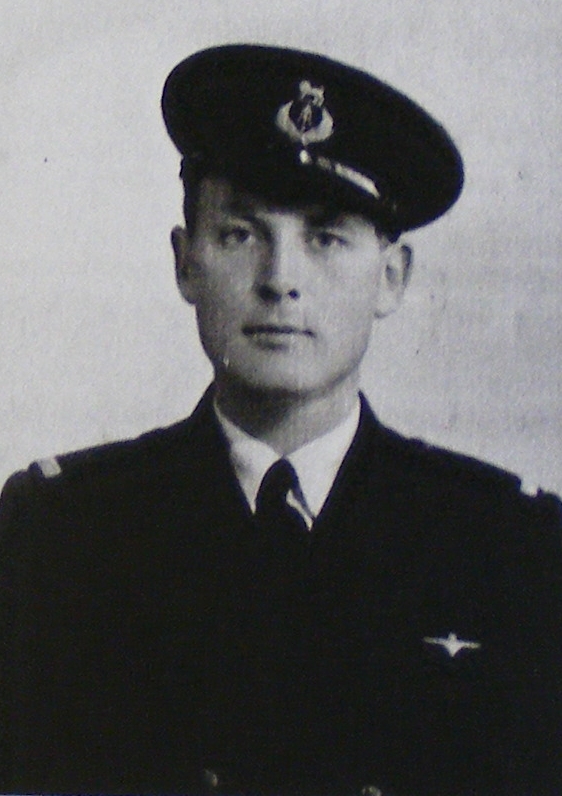
John Harrop SLATER - Second Officer (Co-Pilot)
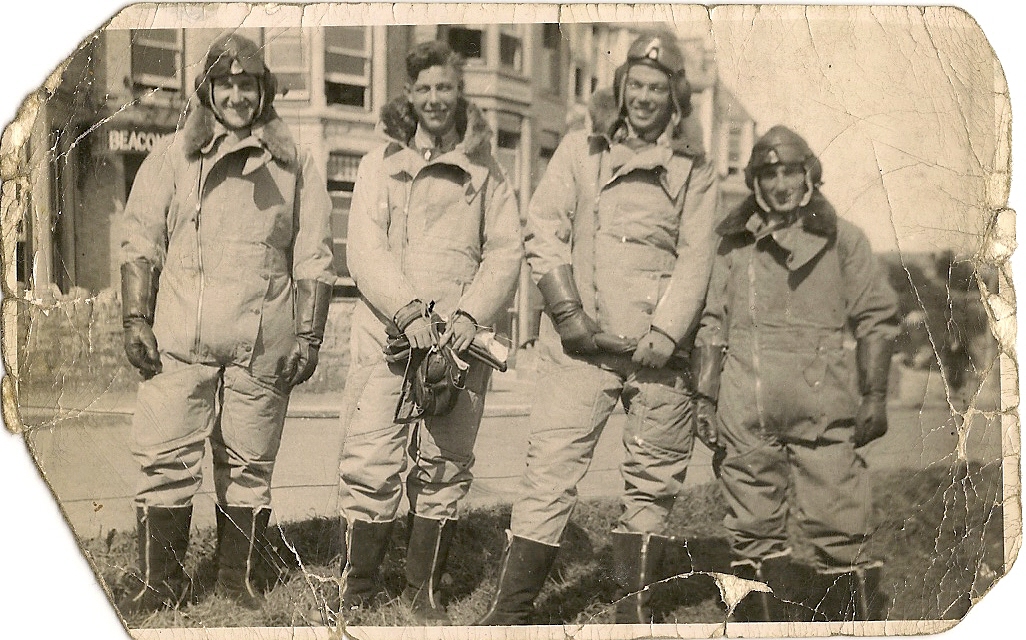
Born in 1922, John H Slater was an RAF Sergeant pilot, serial
number 1314573 seconded to BOAC. He is shown above, third
from the left of the photo, with three unknown airmen. He
was commissioned as an officer later in 1944 with new serial
number 184867. Wartime documents list his next of kin as
his father, F Slater, Rockwell, Malmains Dr., Frenchay, Bristol.
After the war John flew for BOAC for a while in Southern Africa where he met and married his wife. He then farmed Tobacco for a while but went back into the Airline business working for Central African Airways then latterly Zambian Airways. He was briefly mentioned in a 1960 American aviation magazine, Airlift: World Air Transportation, in an article on Central African’s operations: “And at Livingstone, at the falls, JH Slater is more than a personable airline man — he's part and parcel of the community and is active in helping to promote tourism.”
John Slater retired to Devon where he died in 1986.
Eric William VINCENT - Navigator
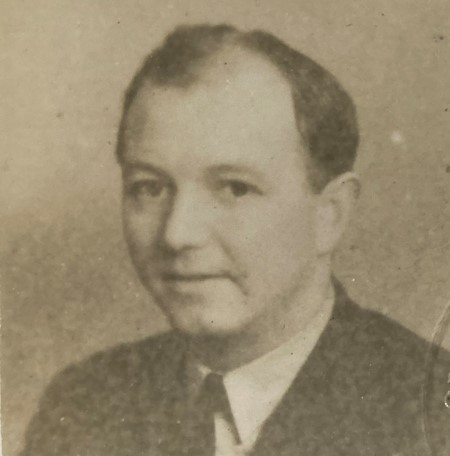 Eric's
address was listed in most newspapers and documents as 6 India
Avenue, Salisbury, Wilts and it is here that he is found on the
1939 register, having been born on 19th August 1920 in
Salisbury. His occupation was a Saloon Waiter on ships and
he was residing with his father, George B Vincent.
Eric's
address was listed in most newspapers and documents as 6 India
Avenue, Salisbury, Wilts and it is here that he is found on the
1939 register, having been born on 19th August 1920 in
Salisbury. His occupation was a Saloon Waiter on ships and
he was residing with his father, George B Vincent.
The Guardian newspaper of July 30th notes that Eric William
Vincent was 22 and had been attached to BOAC from the RAF as a
navigator for over a year. He was trained as a navigator
in Canada in 1942. His RAF service number, 909163, is
mentioned within an air ministry casualty telegram and this can
be matched to his RAFVR commission as officer in 1944 with new
serial number 170393.
His log book recorded the crash in Kerry with startling
simplicity. It shows also his flight home to England in
August and his apparent return to duty in November 1943.
G-AGEW was one of the other BOAC Sunderland aircraft.
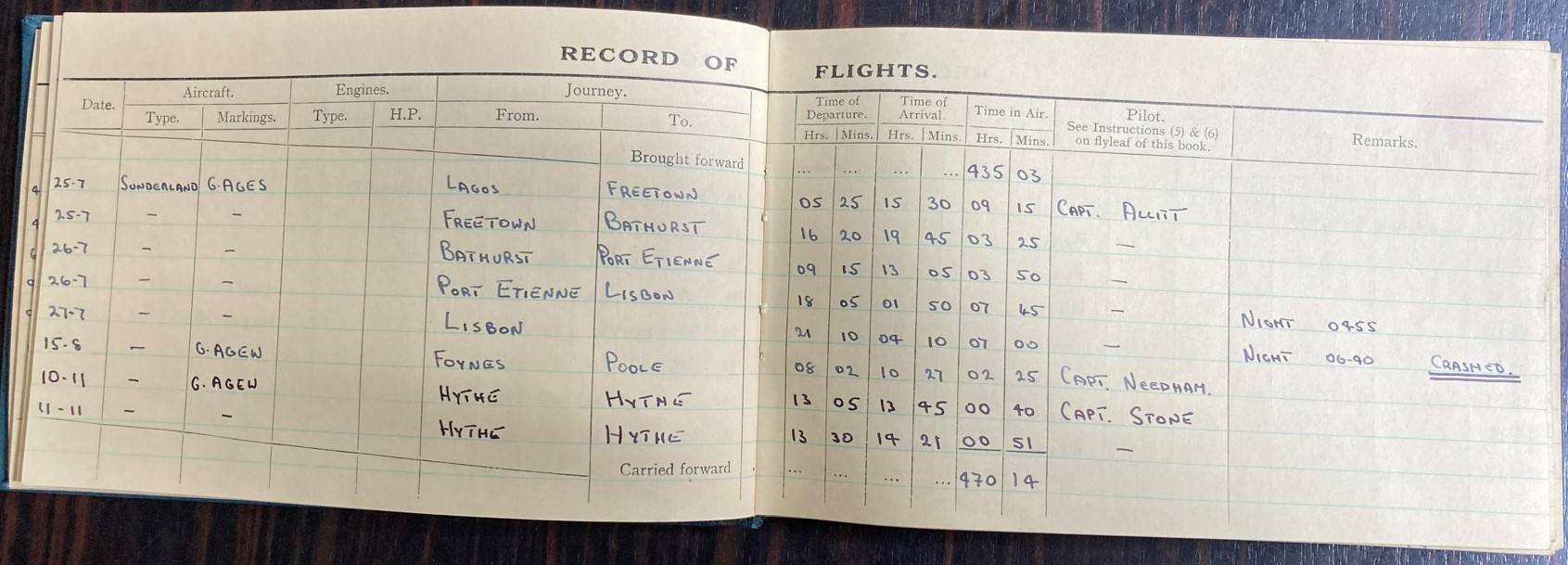
The following page from his brother photo album contains the well known photo of G-AGES tail and a photo of Eric in BOAC uniform.
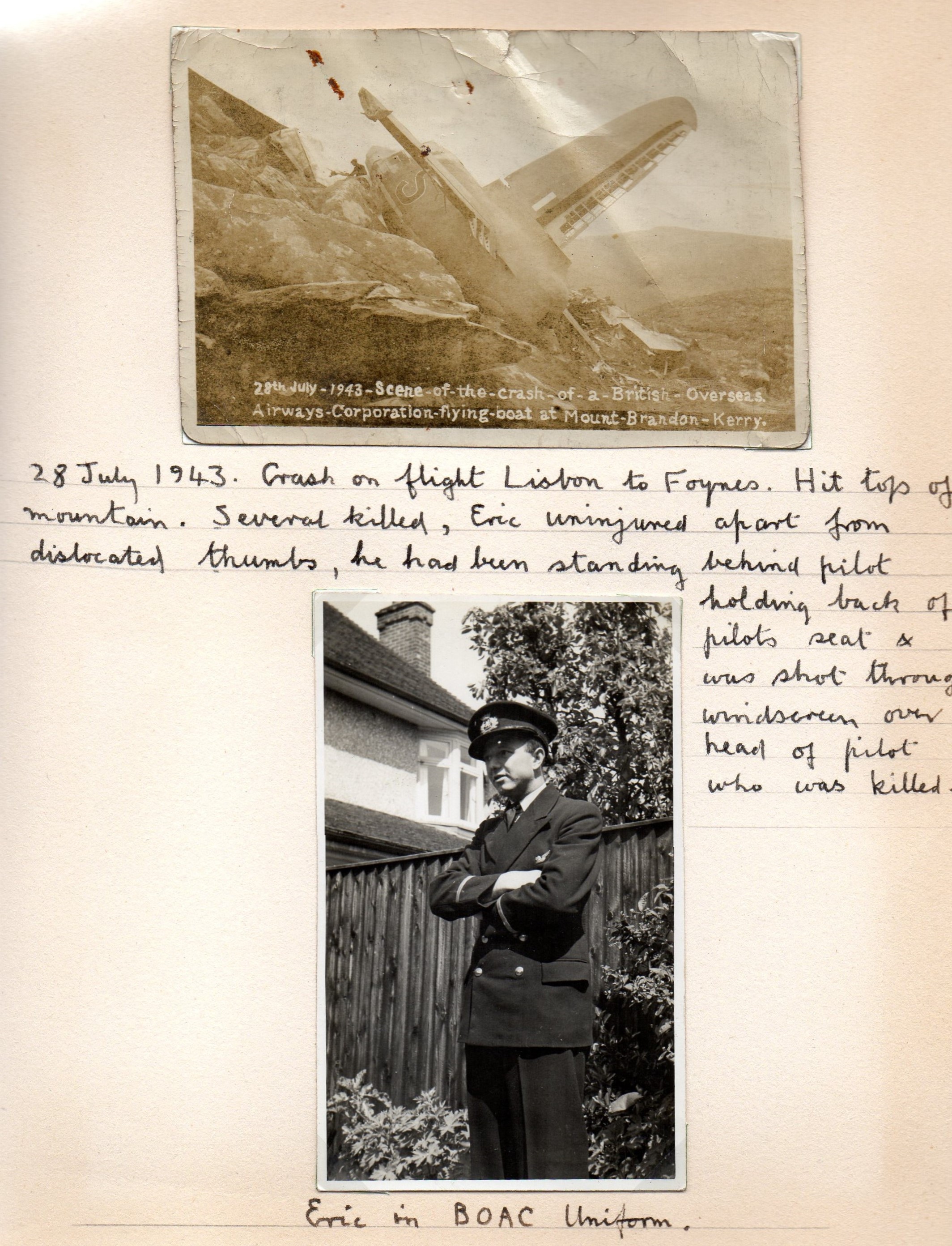
Despite the story of the minor injuries recorded in the above
album, the BOAC archive shows that Eric actually suffered head
injuries and was kept in hospital for a number of days.
In March 1945, he was posted with a new crew to 626 Squadron
flying on Lancaster bombers. His time with 626 Squadron
ended in June 1945 when he was posted out with his crew to 582
Squadron. During his time with 626 Squadron, on the very
last few operational missions, he flew one bombing mission
followed by Prisoner of War repatriation missions and 'Manna'
missions dropping food to the population of Holland.
His crew at this time was:
Pilot, W/O C E Greene 1284921
Flight Engineer, Sgt F E Wilmott, 3001376
Navigator, F/O Eric William Vincent, 170393
Air Bomber, Sgt H Funge, 1674613
Wireless Operator (W/Op) Sgt A E Wiltshire 657318
Rear Gunner, Sgt J S Phillips, 1596517
Mid Upper Gunner, Sgt K A Buxton, 1306055
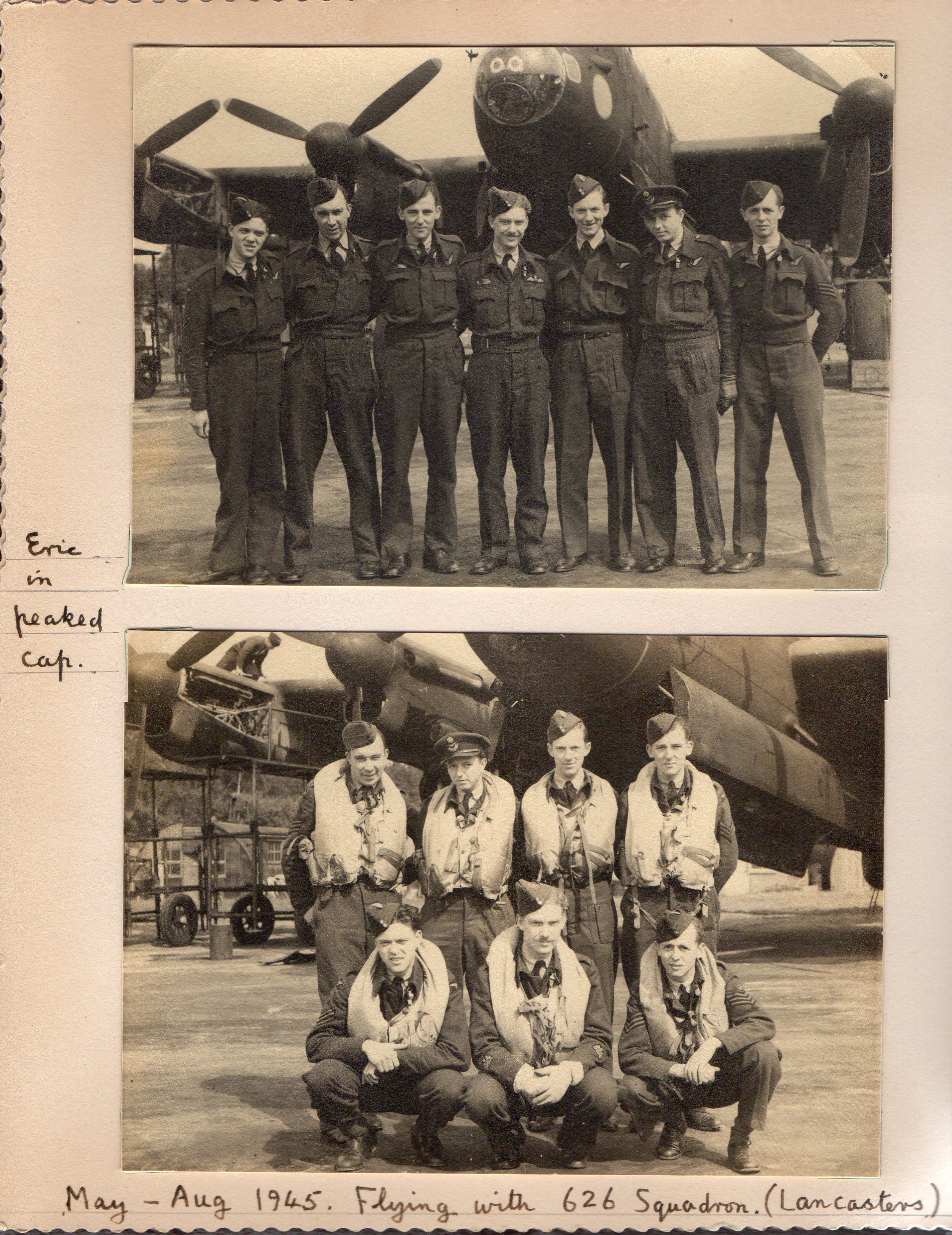
He was the son of Katherine and George B Vincent of
Salisbury. After the war, he continued working for BOAC
until 1966 when he was made redundant. He later was a
member of the RAF Reserve of Officers until 1953. During
this time he remained with BOAC and is mentioned in an edition
of the B.O.A.C. review as late as 1957 when he formed part of
the crew that flew the Queen Elizabeth, the Queen Mother, during
her tour or Africa.
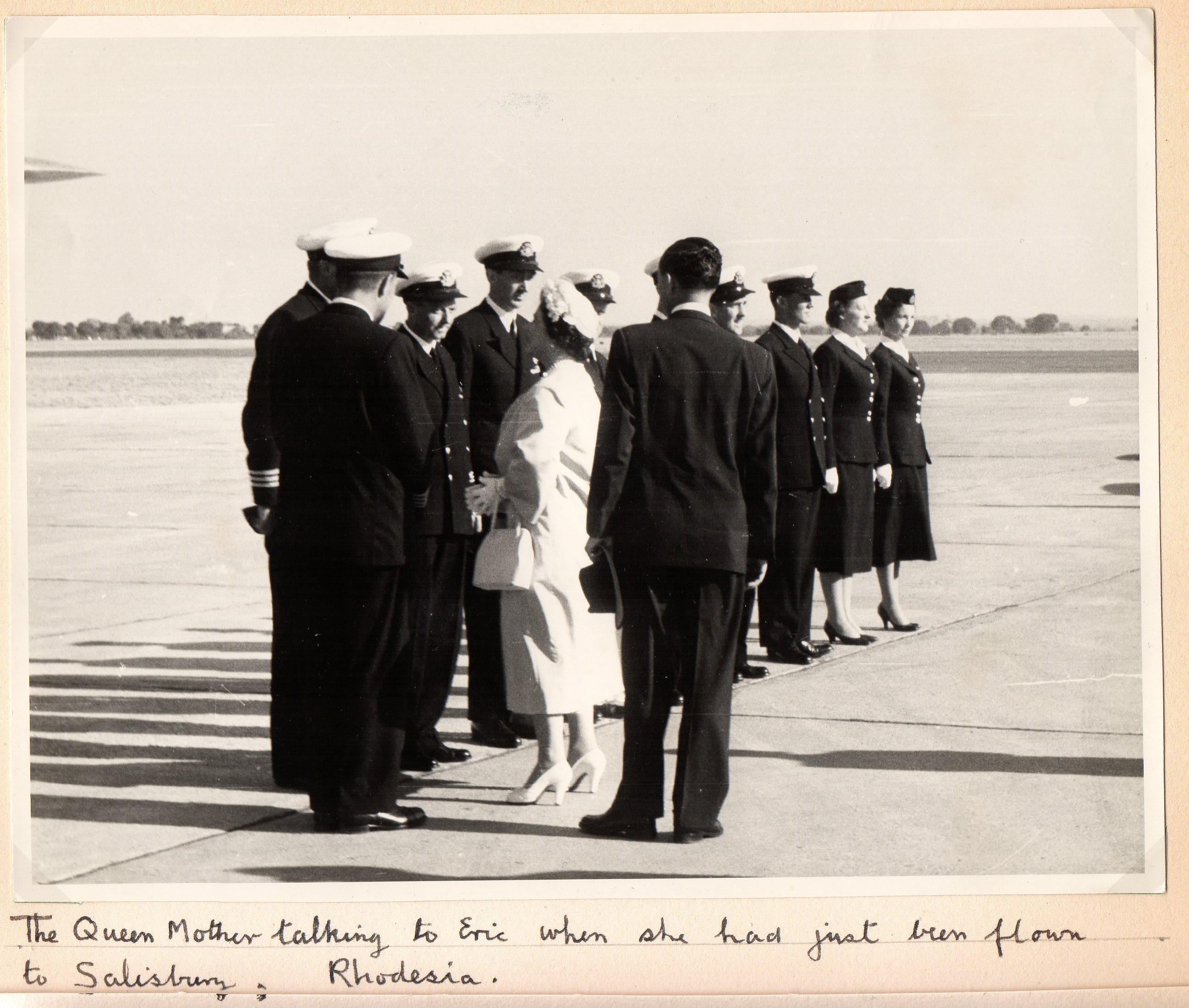
At that point he started working for an optician in
Ilford. By 1973, he had moved to Lancashire and
established his own optician business. He died in April
1983.
Eric never married and left no children.
His nephew was so kind as to provide the accompanying photos
and details.
Harold Albert Victor RAWLINSON - Engineering Officer
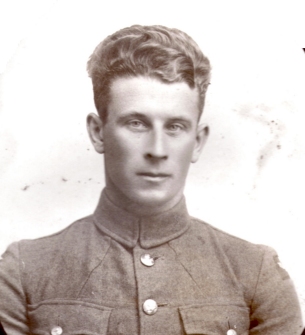 Victor Rawlinson having
escaped from the aircraft and assisted in helping all he could
to escape from the wreckage then made his way down the mountain
side to seek help. He was accompanied by Leonard King who
had suffered worse injuries. They split up along the way
and Victor made his way to the Cottage of Mrs. Corkery.
Victor Rawlinson having
escaped from the aircraft and assisted in helping all he could
to escape from the wreckage then made his way down the mountain
side to seek help. He was accompanied by Leonard King who
had suffered worse injuries. They split up along the way
and Victor made his way to the Cottage of Mrs. Corkery.
He was born in March 1903 to . He married in 1932 to
Elizabeth Leavitt. Documents and newspapers from July-August
1943 typically give his address as Commercial Road, Parkstone,
Dorset. He had joined the RAF in 1925. By 1939 he
was working as an aircraft rigger and living in Solihull.
It is noted on the register that he was an RAF reservist.
In November of 1943, the Flight magazine carried an article announcing that an Engineering Office H. A. V. Rawlinson had been awarded a Letter of Commendation by BOAC for having "exhibited gallantry and devotion to duty".
The October 1943, British Airways 'News Letter' publication recorded the following:
NEWS LETTER records with pleasure the award of Corporation Certificates of Commendation by the Board on 30th September to the following members of the staff:-
Engineer Officer H. A. V. RAWLINSON.
For courage and devotion to duty at Slieve Glas, Eire, on 28th July, 1943, when, as a member of the crew of the aircraft G-AGES, although suffering from shock, having tended the injured, he made his way for about four miles down the mountain side from where the accident occurred to the nearest house to organise help, subsequently returning to the scene of the accident and giving further assistance to the injured.
The BOAC court of enquiry had recommended that Rawlinson be
commended for his actions. In all but one instance is he
named as Victor or V. Rawlinson in the BOAC files, but his next
of kin is described in one list as Mrs. H A V Rawlinson.
Furthermore, a Harold A V Rawlinson features as an Engineering
Officer on many BOAC flights into New York throughout the mid
1950's. His granddaughter Sarah remembers him fondly
and provided the photo above and a copy of his BOAC letter of
commendation.
Victor passed away in 1992 in Bournemouth
Ralph Bousquet LAWES - Engineer
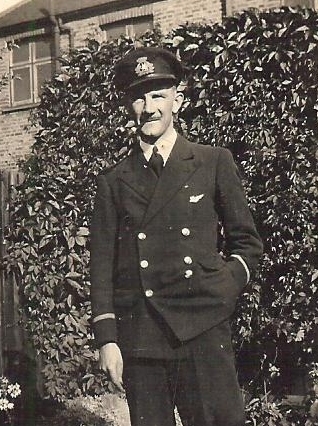
Ralph was born in Croyden in April 1915 to Annie E and James A
Lawes. He attended Whitgift School and following this
joined the Royal Air Force with serial number
1729046. He was married in 1939 married his
wife Joan in 1939 and is fondly remembered by his wife and
daughter Jacqui. A very modest man, Ralph never told much
of his stories, his family understand he received an award or
decoration for his efforts after the crash but sadly details
were not recorded. Ralph's name is found in the London
Gazette in 1945 having been commissioned as an officer in the
Reserve of Air Force Officers. Ralph's name was widely
quoted in Irish newspapers at the time of the crash having been
interviewed in hospital. He was able to escape from his
position in the aircraft and gave assistance to some of the
others in getting free from the wreckage.
After the war, Ralph left BOAC and and traveled to Hong Kong where he worked as an engineer with a maintenance firm. Upon retiring in 1969 he lived in Spain and returned to England in 1982. He passed away in February 2000 in the Salisbury district.
Charles Harry Pyett PHILLIPS - Radio Officer
Charles was born in April 1916 in Gosport and passed
away in July 2001 in the Surrey Northern district. The
1939 register finds him living in Bristol and working as a Radio
Officer in Imperial Airways. Documents and papers from
1943 list his address as Lake House, Elms Avenue, Lilliput,
Dorset. He was awarded a commission in the Reserve of Air
Force Officers in late 1943.
He would be part of the crew of Stratocruiser of BOAC which
flew the Royal family on a tour of Bermuda and Jamaica in
1953. He was a frequent crew member of BOAC flights to New
York in the 1950's.
His name appears in a 1931 British Post Office appointments roll as a certified Radio Operator.
The only photo found so far shows him in 1953, in a line-up of
BOAC crew members which flew the Queen to Jamaica. This
was published in the Flight magazine.
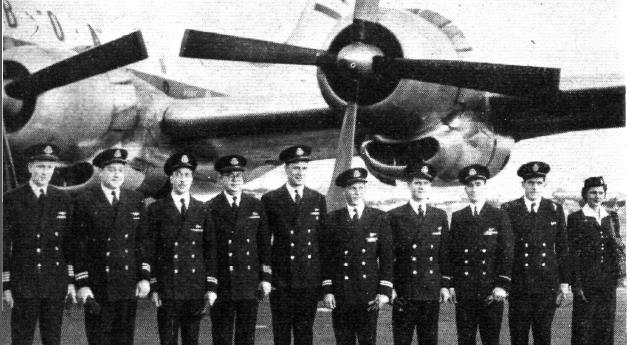
He is identified as R/Off. C H P Phillips and is the fourth man from the left of the photo.
Frederick Thomas James PARR - Radio Officer
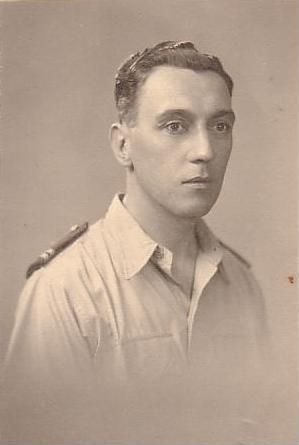 Fred was born in May
1911 in Newark, Nottinghamshire. His address at the time
of the crash was given by newspapers as Dorvan Millane,
Parkiston, Dorset.
Fred was born in May
1911 in Newark, Nottinghamshire. His address at the time
of the crash was given by newspapers as Dorvan Millane,
Parkiston, Dorset.
He was a prewar RAF service member and civilian radio operator,
having a Royal Aero Club wireless operator certificate issued in
February 1938 and he would appear to have been employed with
Railway Air Service, based at Renfrew Aerodrome, Scotland.
The crash of G-AGES was not the first crash that Fred was
involved in during his career, indeed, not even his first of
that year, 1943. In 1933, while in service in India, he
had been seriously injured in the crash of a Westland Wapiti
biplane of 28 Squadron, RAF in a crash during training.
The pilot of the aircraft had been killed in the accident.
On the 13 of March 1943, he was crew member on BOAC's
Consolidated Catalina G-AGDA when it crashed on a training
flight in Poole Harbour. The aircraft burned out and three
members of the crew were killed. Most available sources do
not mention the names of the survivors but Fred's sons were
aware of his being on the aircraft.
His family were able to provide scans of his wartime log book
which shows that the aircraft had flown from Bathurst to Port
Etienne on July 26th, then on to Lisbon on the night before the
fateful crash. Take off time is give as 21:10 from Lisbon
and the arrival column records 04:10.
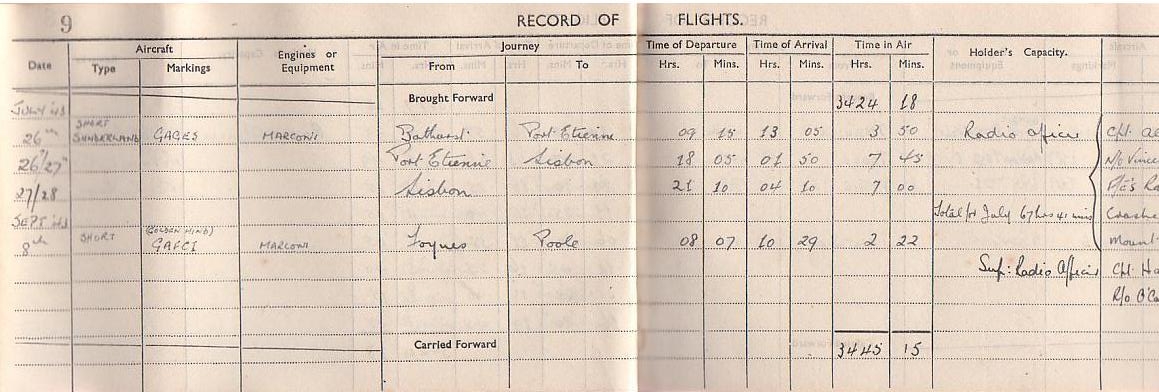
The crash of G-AGES caused severe injuries to his face and he
was treated by the famous Dr. McIndoe. The photo below
shows Fred in 1949.
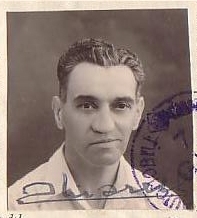
Fred was back on duty by September 1943 however, and he flew
from Foynes to Poole on September 8th 1943. The photo
above was supplied by his son's and dates from December 1942.
In 1946 he was based in Karachi with his wife Erna.
Fred Parr died on the 20th Feb 1989 at home in New Zealand
where he moved in 1950. Despite his misfortune with
flying, he bought and flew his own aircraft in later years.
He was named incorrectly by the contemporary media and also in official reports, for example: BOAC "F J S Farr", AVIA report calls him "F T J Parr", Times newspaper call him "F T S Parr".
Ian Kenneth THOM +
His wartime address was given as Heath Drive, Potters Bar,
Middlesex and he was buried in Killiney Churchyard, Kerry, in
the collective grave.
ian was born in 1906 to John and Edna Thom in Handsworth.
The 1911 census finds him aged 5 living with his four siblings
and parents in Enfield. The 1939 register finds both Ian
and his brother Byron living at home with their parents.
I K Thom was traveling with H Tristram and both were it appears returning from India where they had been representing the De la Rue Plastics company. The Death certificate registered on November 8th 1943 for Mr. Thom does not have any address details but does say that he was 37 years of age. England and Wales GRO records an Ian Kenneth Thom registered as born in the first quarter of 1906 in the West Bromwich district. No marriage record found for him anywhere and his next of kin was listed as his father. The memorial stone raised on the grave was paid for by B.O.A.C. He is not mentioned in the Irish Army G2 report.
A 1943 publication “The Chemical Age”,
carried the following announcement: Two officials of De La
Rue Plastics, Ltd., were killed recently in an aeroplane
crash in Southern Ireland. They were Mr. I. K. THOM,
works manager of the Walthamstow works and Mr. H. Tristram
of the works in Scotland.
His probate record
lists his brother Byron as beneficiary.
Harold TRISTRAM +
Harolds address is found as being Rosebank, Prinlaws, Leslie, Fife, Scotland and he was husband of Sybil Elene Tristram. His remains were buried in Killiney Churchyard, Kerry.
There is very little known about Harold Tristram. He was
one of a family of four born at the turn of the century in
Essex. He was, like Mr Thom mentioned above, a member of
the De La Rue Plastics company. There is almost no mention
of him in the Irish Army report. The memorial stone raised
on the grave was paid for by B.O.A.C.
Both Tristram and Thom were buried in the communal plot in
Killiney graveyard. The headstone is shown below.
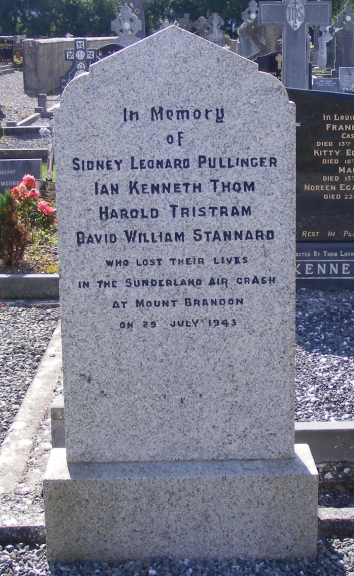
Sidney Leonard PULLINGER + (Acting Colonel, 65857 Royal Engineers, British Army)
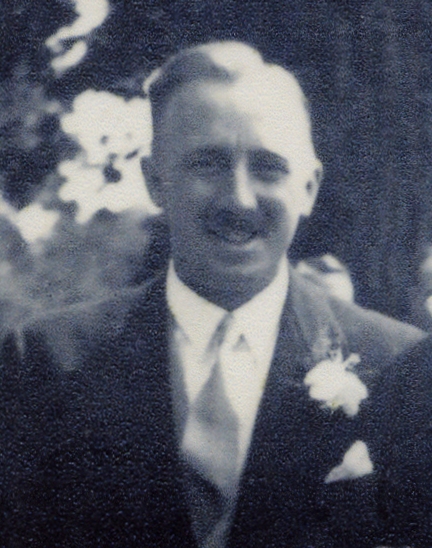 Son of Sidney Abraham and Maria
Rebecca Pullinger, husband of Irene Pullinger, A.M.lnst. M. and
Cy.E., A.I.A.A.
Son of Sidney Abraham and Maria
Rebecca Pullinger, husband of Irene Pullinger, A.M.lnst. M. and
Cy.E., A.I.A.A.
He is buried in the common grave in Killiney Churchyard, Kerry. but also has a CWGC headstone inscribed as follows: Thy Purpose Lord, One cannot see, But all is well, That is done by thee.
He has no specific mention in the Irish Army report except a mention that he was in the Royal Engineers.
The BOAC Museum file referred to him as 'Fullinger', all other sources correctly name him Pullinger.
The Institute of Civil Engineers advised that he was an
Associate Member, Institution of Municipal and County
Engineers. became an Associate Member of Inst M & Cy E
in 1933. He passed the Testamur and the Town Planning
Certificate. In 1940 he gave his address as County
Surveyor ’s Dept. Silver Street Hall, Trowbridge. He was on
active service at the time. There was no obituary
published by Inst M & Cy E.
The England and Wales GRO register lists a Sidney Pullinger
birth registered in the last quarter of 1905, in the Newport M
District of Wales, making him 38 years of age. He is
listed on the Army Roll of Honour as being born in Newport and
residing in Wiltshire which would match up with
Trowbridge. Wiltshire Council Local Histories office
advised that an 'S. R. Pullinger' is named in the Trowbridge War
Memorial. CWGC has no name to match this so his name may
be spelt in error on the memorial. An S L Pullinger was
listed in the West Wilts directory in 1939 and 1940 as living at
38 Clarenden Road. The letters A.I.A.A. indicates he was
Architect Member of the Incorporated Association of Architects
and Surveyors. The memorial stone raised on the grave was
paid for by B.O.A.C. His wife Irene passed away in
1951. Due to his wifes illhealth, his sister Doreen's name
appears in correspondence from 1943 and 1944.
The Wiltshire Times of August 28th 1943 carried a notice of his death, but names him as Col. S R Pullinger. A letter in a February 1944 issue of The Wiltshire Times carried a letter written by a Capt. A J H White, R.A.O.C., in which he recorded he wartime experiences in the Middle East and mentioned that he had met Col. Pullinger in both Egypt and Syria.
David William STANNARD + (Acting Grp/Capt , 36119 Royal Air Force )
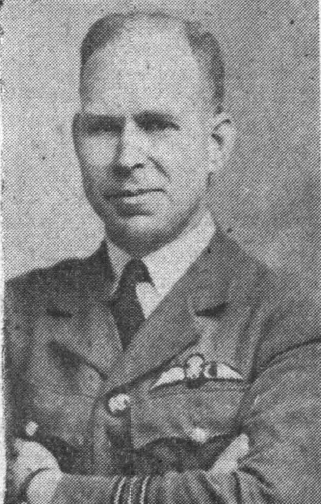 G/Capt. Stannard was aged 34, Son of
William and Mary Stannard and husband of Ursula Stannard, of
Lovelace Gardens, Surbiton, Surrey.
G/Capt. Stannard was aged 34, Son of
William and Mary Stannard and husband of Ursula Stannard, of
Lovelace Gardens, Surbiton, Surrey.
He is one of those buried in Killiney Churchyard, Kerry. The memorial stone raised on the grave was paid for by B.O.A.C. but he is also remembered with a CWGC head stone.
He gets no detail mention in the Irish Army G2 file.
Stannard was born in 1908. He is mentioned in Flight
Magazine September 1944 where he had been returning from an
inspection of Zanzibar with relation to creating a labour force
for aircraft service in West Africa. His obituary was
printed in the October 30th, 1943 Times newspaper.
Recorded as being from ‘Oldeby’ but no such place seems to exist
so it must be Aldeby, Norwich. The RAF Honour Roll states
him to have been serving with the Air Ministry at the time of
his death.
From The Times, Saturday October 30th, 1943
ACTING GROUP CAPTAIN DAVID WILLIAM STANNARD, killed on active service, was born at Oldeby (D Burke: Aldeby), Norfolk, in 1908. He joined the R.A.F. as an aircraft apprentice in 1924, trained as a coppersmith and metal worker, and in 1929 remustered for training as pilot, becoming a sergeant pilot in 1930 and a flight sergeant in 1937. On February 24, 1938, he was granted a permanent commission as pilot officer, on probation and was confirmed in appointment a year later. Until after the outbreak of war he served at the Aircraft and Armament Experimental Establishment. He was promoted flying officer in 1939, flight lieutenant in 1940, squadron leader in 1941, acting wing commander in April, 1943. He completed satisfactorily a short war course at the R.A.F. Staff College.
The Beccles and Bungay Journal newspaper from Norfolk included an extensive obituary for W/Comm Stannard. It’s August 21st publication recorded:
LATE WING-COMDR D. W. STANNARD
Was An Old Boy of Beccles School
An old boy of Sir John Leman School, Beccles, who had done splendidly in his Royal Air Force career, lost his life when a British Overseas Airways flying boat, in which he was a passenger crashed in Eire.
He was Wing-Commander David Wm. Stannard. second son of Mr. W. Stannard and brother of Mrs. E. Moore, who live at 12, Council Houses, Marsh-lane, North Cove. Aged 34, he was a married man with two young children, the family's home being in Surrey.
Born at Thwaite St. Mary, Wing-Commander Stannard first went to Ellingham School and afterwards to that at Geldeston, his parents then living at Gillingham. From Geldeston he won a scholarship to Sir John
Leman School. Leaving at the age of 16, he joined the R.A.F., in which he had served up to his death. He studied hard, and his various promotions came as a fitting reward for his efforts.
Two years ago Wing-Commander Stannard visited his old school on the occasion of the annual athletic sports and prize distribution, and spent an interesting time chatting with various friends. He was highly popular with all who knew him. Whenever opportunity permitted he used to visit his father at North Cove.
Lewis MILNER +
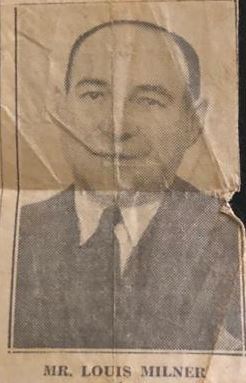 Simmonds
St, Johannesburg, S.A., Manager of E. W. Tarry & Co.
Simmonds
St, Johannesburg, S.A., Manager of E. W. Tarry & Co.
Next of kin, mother Mrs. A. Milner at 28 Osborn Road, Fellside, Johannesburg.
He is buried In Curraghkippane Cemetery in Cork. He had
been originally buried with the other casualties in Kilmmurrey
but as of January 1944, a newspaper article stopped by the Irish
government censor mentioned that the Jewish Organisation of
South Africa was asking for his remains to me moved to
Cork. The cemetery records then show that he was
re-interred there in Cork on the 27th January 1944.
Contact made in December 2007 with the family of his late
sister Freda and in 2021 a grand neice was able to provide the
attached photo. The Guardian Newspaper of July 1943 said
that Mr. Milner had been on government business from the
Director of Supplies of South Africa in connection with supplies
of machine tools. The E W Tarry company was a large
wartime company it appears based in London but with facilities
in South Africa. Mr. Thompson was named as his colleague
on this mission.
His family had this photograph of his headstone.
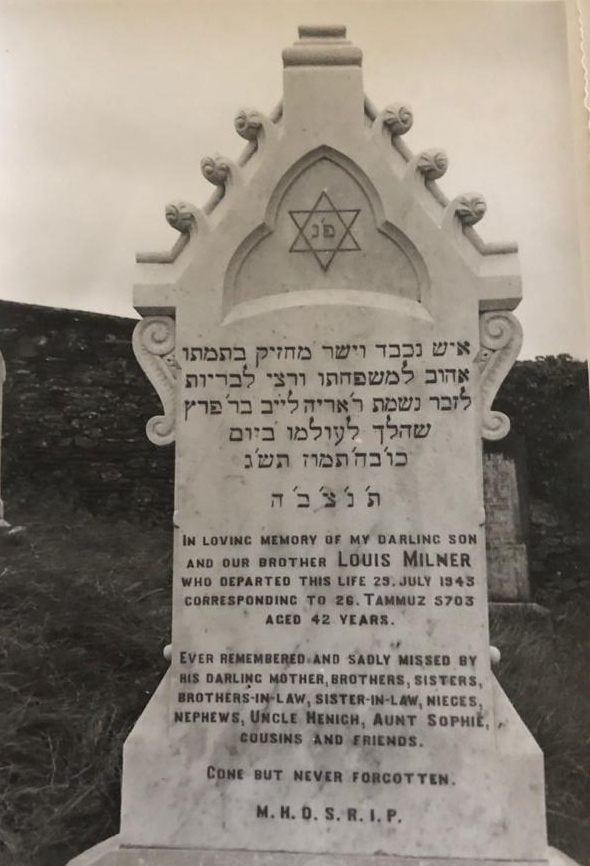
An as yet unidentified South Adrican newspaper published the
following obituary with the photo following his death.
City Bussinessman Killed in Eire Air
Crash
LONDON, Friday - One of the ten persons
killed when a British Overseas flying-boat crashed in Eire
on Wednesday was Mr. L Milner, manager of Messer. E. W.
Tarry and Company, Ltd., Johannesburg, who had been sent on
a mission to England by the Union Direction -General of
Supplies in connection with the supply of machine tools,
reports SAPA-Reuter.
Mr. Milner, who was 43 years of age was born in
Lithuania, and came to South Africa when he was four years
old. He spent most of his life in Kimberly, and was
educated at the Kimberly High School, joining the staff of
Messers. E. W. Tarry and Co. there as a youth. He came
to Johannesburg in 1929 as manager of Messers. E. W. Tarry's
Johannesburg branch.
Mr. Milner was a recognised authority
on the tool industry and its requirements in the
Union. In 1935 he attended a businessmans conference
in the United States, and also visited England. He was
well known in mining and commercial circles on the
Witwatersrand.
He was unmarried. His mother, three sisters and
three brothers, two of whom are in the army and have been on
active service up North, live in Johannesburg
Mr. Milner's colleague on the mission, Mr. T. W.
Thomson, who is among the injured, is a railway engineer
in Pretoria and (missing
word) seconded to machine tool (missing word)
Max Albert ROTH +
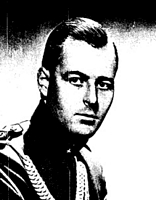 Max was born on February 15, 1912, and was aged
31 at the time of his death. His parents were Albert and
Berta from St. Gallen in Eastern Switzerland.
Max was born on February 15, 1912, and was aged
31 at the time of his death. His parents were Albert and
Berta from St. Gallen in Eastern Switzerland.
He married Miss Edith Shipman Douglass on March 7, 1943 in New York’s, St. Bartholomew's Church. They lived at 404 East 55 Street, New York.
Max was a courier with the Swiss legation, and was due to travel to onward to the USA. He was known to Capt. Hewitt, the Irish Army intelligence officer at Foynes. Immigration records show him arriving on various Clipper flights for the thirteen months prior to the crash. He traveled to New York at least once a month during those months.
The remains of M A Roth were brought to Golders Green Crematorium in London and cremated there on August the 5th. His ashes were then flown to New York to his wife in December 1943 and were interred in her families plot in New York’s Green Wood Cemetery.
His wife Edith never recovered from Max's death, having previously lost both her brother and mother in tragic circumstances. She took her own life in April 1948. Her will requested that an alumni room be created in Rutgers College in the name of her mother. She is buried alongside her husband, father, mother and younger brother who all pre-deceased her.
Arthur Frederich Rawson LUMBY + C.I.E. O.B.E. (Colonel, British Army)
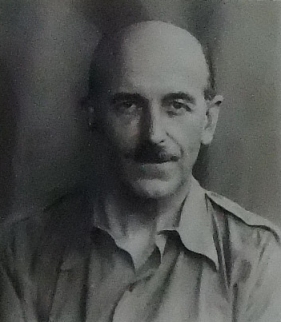 Age 52, Son of the Revd. Joseph Rawson Lumby,
D.D. and Luise Lumby; husband of Lettice Mary Lumby (nee
Hodgkinson), of Askerswell. His wartime address was 23
Gypsy Lane, Haddington, Oxford. He was buried in Askerwell
(St. Michael) Churchyard, Dorset on August 5th, 1943.
Age 52, Son of the Revd. Joseph Rawson Lumby,
D.D. and Luise Lumby; husband of Lettice Mary Lumby (nee
Hodgkinson), of Askerswell. His wartime address was 23
Gypsy Lane, Haddington, Oxford. He was buried in Askerwell
(St. Michael) Churchyard, Dorset on August 5th, 1943.
The Times newspaper recorded his death as Killed in Flying accident, no rank.
A World War One Veteran, he had served with the 2nd Punjab Regiment.
Contact was made with his grandson in September 2007, who had visited Mount Brandon. His military history is described in the book, The Deceivers: Allied Military Deception in the Second World War by Thaddeus Holt - 2004, Page 169:
The Army assigned Lieutenant-Colonel A. F. R. Lumby, known to his friends as "Fritz." Lumby was an elderly and kindly officer, tall, thin, dark, with a quiet voice, a shy manner, a bawdy sense of humor, and a casual attitude to smartness of military dress, who had lost a leg at Loos in 1915. In the interwar years he had been in intelligence in India, and in the later years a member of the Indian Legislative Assembly. He had retired in 1939 but had soon been recalled to organize the Military Intelligence School, where he had been commandant for two and a half years. He came on board as the first officer of the deception section in December.
In a footnote, Holt explains that Lumby was returning to the UK to take up a post with the ISSB having spent a year working for SOE in Africa, when he took over the seat of another officer and reporter, Malcolm Muggeridge at Lagos. His book, "Infernal Groves" tells how he learned that the one legged colonel who had swapped with him had been killed in a crash near Shannon.
His service in Gold Coast is described in some detail by N E Lawlor in her book, Soldiers, Airmen, Spies and Whisperers.
The correspondences with BOAC after the crash clearly state his employment by the Political Warfare Executive. A file on Col. Lumby exists in the UK National Archives in the records of the Special Operations Executive. On the day before he died, the exploits of his son, M G R Lumby, as commander of the Royal Navy Submarine Saracen were published in national newspapers. But to add to his wife’s ordeal, his son was taken prisoner after the Saracen was sunk off Sicily in August 1943.
Diarmuid John HARTIGAN + (Capt. 69053 , Royal Artillery, British Army)
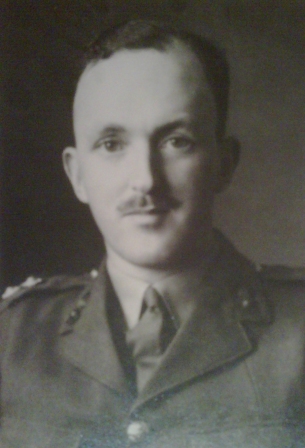 Aged 27,
the son of Dr. John Hartigan and Ethel J. Hartigan, of
Badgworth, Somerset. Buried in Bruff Catholic
Cemetery. The GRO Army Honour Roll lists him as born in
Cardiff and residing in Surrey. The GRO births register
does record a 'Diarmind' J Hartigan as being registered in the
Cardiff district in the third quarter of 1916, his mother’s
maiden name being Duncan. The London Gazette of 28 August
1936 records his being commissioned as a 2nd Lieutenant in the
Royal Artillery.
Aged 27,
the son of Dr. John Hartigan and Ethel J. Hartigan, of
Badgworth, Somerset. Buried in Bruff Catholic
Cemetery. The GRO Army Honour Roll lists him as born in
Cardiff and residing in Surrey. The GRO births register
does record a 'Diarmind' J Hartigan as being registered in the
Cardiff district in the third quarter of 1916, his mother’s
maiden name being Duncan. The London Gazette of 28 August
1936 records his being commissioned as a 2nd Lieutenant in the
Royal Artillery.
He served with 22nd Mountain Battery, Royal Artillery in East Africa during 1940/1941. 22nd Mountain Battery was an Indian Army unit which seen service as part of the African forces fighting in East Africa in 1941. It had arrived in East Africa in September 1939 and was part of 11th African Division until the divisions disbandment in November 1941.
The History of the Indian Mountain Artillery By C. A. L.
Graham mentions a D. J. Hartigan serving with the 22nd Mountain
Battery during the campaign in East Africa and that he lost a
leg after stepping on a landmine.
The final assault on Gondar was
carried out on 27th November with all available artillery
support. By 1730 hours the Italians had capitulated and the
campaign was over.
The attack on Gondar had set a difficult problem for
the officer commanding the 22nd Mountain Battery. He was
given twenty-one days to convert to pack, having neither
mules nor saddlery within 1,500 miles. This change was
necessary in order to get the guns to the position from
which to support the attack. Captain D. J. Hartigan
ransacked the countryside as far as Asmara and eventually a
queer collection of mules and ponies were produced. Saddlery
was improvised, and Abyssinian irregulars carried two rounds
of ammunition apiece in nosebags. However, it worked. The
guns descended a very steep escarpment and came into action
in support of the attack as ordered.
His service record confirms his being wounded in action on the
28th of November 1941. He must have gotten his initial
treatment in East Africa before a posting of four months to
South Africa in late August 1942. He was returned to East
Africa in December 1942 and remained there until being posted
back to the UK on the 12th July 1943. During most of the
time from mid July 1942 to the summer of 1943 he is recorded as
being on sick leave.
His father had died on May 4th 1941 at Corrabul, Weybridge at the age of 64.
The Irish independent of July 30th carried his death notice:
“HARTIGAN (Weybridge) - As a result of flying accident, Diarmuid, eldest son of the late Dr. John Hartigan and Mrs. Hartigan, Weybridge, Surrey, and a grandson of the late Dr. and Mrs. Hartigan, Tarbrook, Croom, Co. Limerick. Funeral from Bruff Church at 2 o'c (N.T.) to-day (Friday) to adjoining cemetery.”
The Irish Army report mentioned that he was returning from Nairobi but how they obtained this information is not recorded. In 1987, two of Diarmuid's sisters visited the Mount Brandon area. His grand niece Jane was kind enough to share her family’s memories of him and photos.
Kenneth Joseph DEVALL + (Sgt, 1577068 Royal Air Force Volunteer Reserve)
Age 20, Son of Frank Clift Devall and Florence Adelaide Devall, of Dudley.
Buried Dudley Borough Cemetery. (CWGC)
Kenneth’s brother, Ray was contacted in January
2008. Ray Devall had visited the museum in Foynes
some years previous and was able to view the engine remains that
lie there and get a potted history of the crash. The
Devall family knew that Kenneth had come down in Portugal back
in June 1943 and Kenneth had written to his mother from there,
in a letter that was posted in the UK by someone returned from
Portugal. Notification of Kenneth's death came from
correspondence from BOAC to the family. It was BOAC who
informed them of his burial and who later flew his remains back
to the United Kingdom in March 1944. Kenneth's brother
Ray, did not believe the RAF or the war office ever contacted
the family in an official regard in relation to Kenneth's
death. Kenneth was mentioned in the newspapers as one of
those buried in Castlegregory on July 29th. His local
newspaper the Evening Despatch of 30 July 1943 published the
notice shown below.
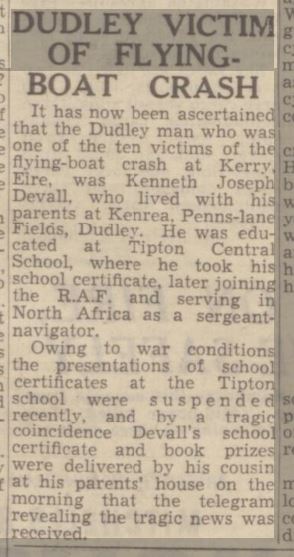
A censored article in the Cork Examiner reported his remains were moved to England in 1944.
He was the navigator on Wellington HZ542 which was forced to crash land in Portugal on 13th June 1943 (See below). He was returning from Portugal on G-AGES when the crash occurred. He is recorded on GRO RAF Honour Roll as posted to 3 OADU.
Ray remembers his brother as being a very clever lad, having many distinctions in his school leaving certificate. He was quite a mathematician and hoped to become a pilot when he volunteered for the RAFVR but instead was given the exacting role of Observer (navigator). He undertook some of his training in Miami, Florida. Ray himself served three years in the Far East during the war. Kenneth’s brother Ray passed away in 2009. Ray sent on in 2008, photo copies of four photos taken of Kenneth and his compatriots while interned in Porto. These can be seen below.
Leonard KING (Pilot Officer, 139574, Royal Air Force)
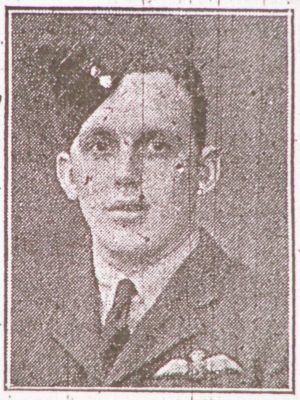 Age
22, 55 Moffat St, Maidenhead, Berks, England.
Age
22, 55 Moffat St, Maidenhead, Berks, England.
Born 25 May 1921 to Leonard and Margaret King, Leonard worked with the High Duty Alloys Company before his service with the RAF and was he was an amateur runner. The 1939 register find him resident with his parents at Bridge Street where he is recorded as being an RAF Sergeant, though the details recorded are difficult to make out. He had been in the RAF only since August 1939 per his escape and evasion form. He lived at the 55 Moffat Street address in 1943 with his wife and his mother ran the local Waterloo Cafe. He was a pilot and had trained at 15 OTU. The Guardian newspaper reported him as having served on up to 40 missions with Bomber Command. He had completed a tour of duty with 115 Squadron, flying Wellingtons on raids over German and Europe in late 1940 through to may 1941. His local paper the Maidenhead Advertiser also carried a story on him praising his efforts in assisting the injured. Despite his injuries he walked down the mountain side with Victor Rawlinson and made his way to another house, his injuries not allowing him to travel with Rawlinson to the Corkeries house. He was the pilot of Wellington HZ542 which was forced to crash land in Portugal on 13th June 1943 (See below). He was returning from Portugal on G-AGES when the crash occurred. He left Foynes on August 4th, arriving in Poole from Foynes on August 5th. He is recorded in the London Gazette as being an RAF officer up until 1955. He died in 1989, his death being registered in the Slough district.
His escape and evasion report is MI9/SPG: 1334 310 Ferry Unit (L. King)
Victor Francis Edward SIMMONS (Sgt, 1295159, Royal Air Force )
12 Nelgaarde Road, Catford, London SE6
He was the wireless operator of Wellington HZ542 which was forced to crash land in Portugal on 13th June 1943 (See below).
England and Wales GRO seems to list him as birth registered in last quarter of 1920 in the Woolwich district near London. His marriage to Joyce Monshall can be found in the 1945 marriage index in Lewisham district. His name then appears in the 1963 death registers where he had passed away at the young age of 42 in the Bromley district. He was resident in Chislehurst at the time.
Roy Elliott BERTRAM (Sgt , 1606485, Royal Air Force)
A wartime address of Woodside, Tivoli Cres., Brighton was given
in reports and media.
Born 29 Aug 1923 and listed as working as a Grocer's assistant pre war. The Guardian newspaper and a Censored Irish Times report said he was born in the Channel Islands and had escaped with his parents on the last boat before the German occupation. Joined the RAF as an Air Gunner.
He arrived in Poole from Foynes on August 5th. He was the air gunner on Wellington HZ542 which was forced to crash land in Portugal on 13th June 1943 (See below). MI9/SPG: 1335 310 Ferry Unit (R. E. Bertram).
He married Doreen E Cook in the third quarter of 1945 in
Brighton. Following the crash and recuperation, he joined
Oliver Frith in going to 218 Squadron, where they both served in
the same crew under F/Lt Kenneth A J Ellis. They are shown
in the wonderful crew photo below, with Roy second from
Left and Oliver Frith next to him, third from left.
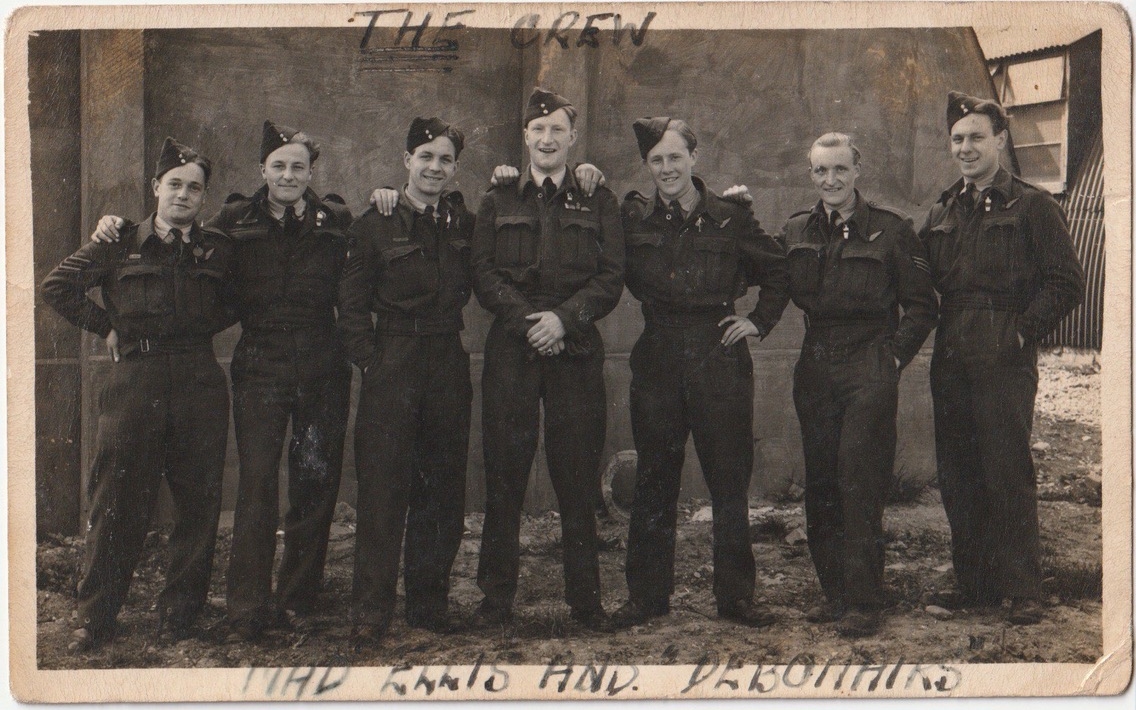
From the London Gazette his career in the RAF can be seen, he was commissioned in 1944, transferred to the Secretarial Branch of the RAF after the war and rose to the rank of Wing Commander, retiring in 1976. A former neighbour recalls his running the newsagents in Burgess Hill, Sussex up until his death in early 1983.
Oliver FRITH (Sgt , 1319140, Royal Air Force)
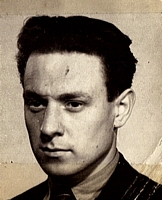
Oliver's son Mark was kind enough to provide details about his
father. Oliver was born 25 Feb 1922. He joined the
RAFVR in October 1941 and trained as a bomb
aimer/observer. Part of this training took him to 41
Air School in South Africa before returning for crew training at
RAF Harwell with 15 Operational Training Unit (O.T.U.). It
was with his new crew that he was enroute to North Africa when
events took place that brought him to be on board
G-AGES. He was the bombardier of Wellington HZ542
which was forced to crash land in Portugal on 13th June
1943 (See below). Interned for a short time he was
released and returned to England on the BOAC flight. After
the crash, he remained in Tralee hospital until August
7th. After his return to England he returned to crew
training this time with 26 O.T.U. located at RAF Wing. He
was placed with a new crew under F/O Ellis and he stayed with
this officer through further training with 1653 Conversion
Unit. There, in April 1944, he changed from flying in the
venerable Wellington bomber to the mighty four engine
Stirling. From there he moved on to his operational
posting with 218 (Gold Coast) Squadron. On the 10th June
1944, four days after D-Day, Oliver flew probably his first
operational sortie of the war when F/O Ellis took his crew on a
mine laying mission off the Dutch coast. These flights
continued until August of that year when the squadron
transferred to the Lancaster bomber, an aircraft better suited
for the bomber offensive against Germany. The remainder of
Oliver's war involved bombing missions to Germany and occupied
Europe including some of the first day light bombing raids by
bomber Command since 1941. Oliver's Flying Log Book is
marked TOUR EXPIRED – 35 OPS on 27th November 1944. He was
commissioned as an officer in the RAF in 1944. Oliver married in
1944, having met his wife, Doreen in the RAF. He mentioned
little of his war time service in later life. His son does
recall him mention that he didn't think anyone from his original
training group survived the war. His escape and evasion
file at the UK National Archives is: MI9/SPG: 1337 310 Ferry
Unit (O. Frith). On this he lists his pre war profession
as being a shipwright. The address he gave to the Irish
Authorities at the time was 66 Torrington Rd, North End,
Portsmouth. Oliver passed away in 1981.
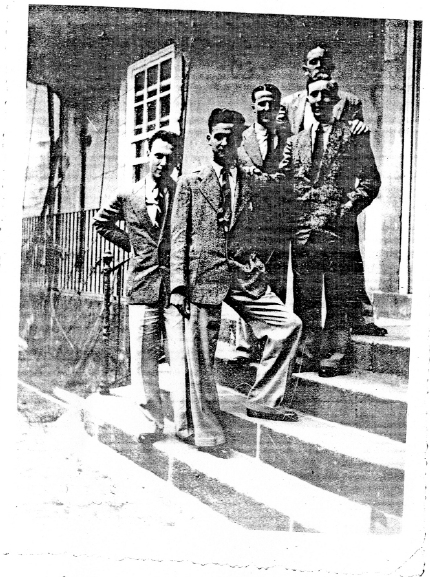
Kenneth Devall's brother Ray was able to provide the above
photo which he described as being:
P/O King is second from the left, the air gunner is third from the left and my brother is on the extreme 'left'.
It is understood that he meant his brother was on the extreme right of the photo based on the other photos sent and the men’s attire.
Oliver Frith’s family recognized him as second from the right, next to the gate pier.
Ray notes that this photo is stamped on the back: 'Photo Stand 23rd Feb 1944" Porto.
The above photo would appear therefore to contain the crew of
Wellington HZ542 during their brief stay in
Portugal. The only air gunner listed in the crew of
HZ542 was Roy Bertram, thus the man standing at the extreme left
may be V F E Simmons.
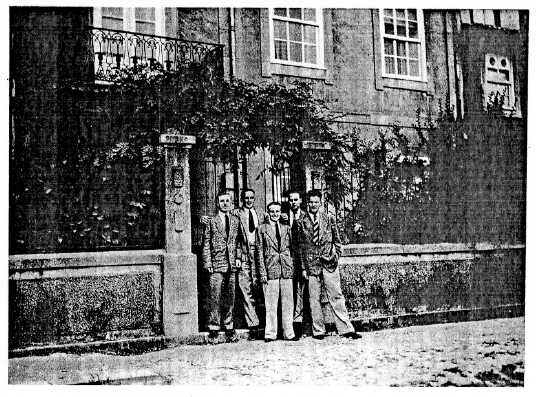
In this other image, shown above, marked with the same “Photo
Stand 23rd Feb 1944 Porto” stamp sent by Ray Devall, his brother
Kenneth is standing at the front of the group. P/O Leonard
King is stood on the top step. He noted the man standing
beside P/O King was “the rear air gunner”, this is thought to
mean Sgt Roy Bertram. The man stood behind Kenneth
Devall's shoulder is Oliver Frith.
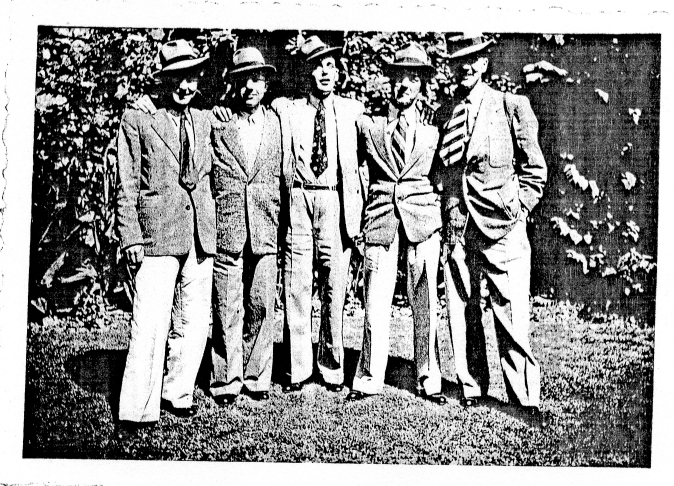
In the above photo, P/O King is in the center with Kenneth J
Devall on the far left. Kenneth’s brother, Ray, understood
these were taken in the grounds of the British consulate This
photo is stamped on the back: "Photo Stand 2 July 1943.
Porto"
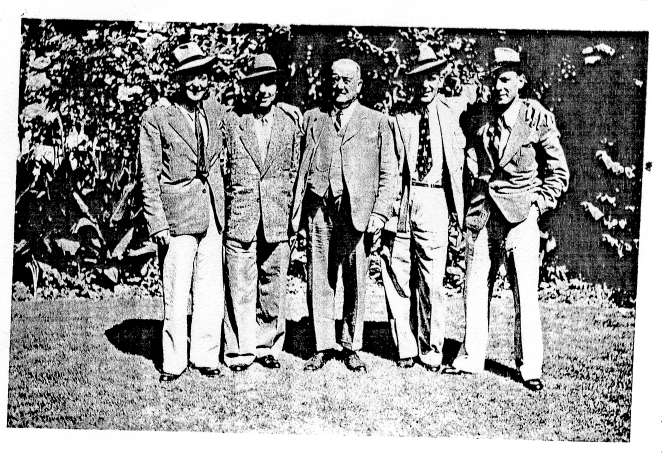
In this photo, the man standing at the center is understood to have been a member of the British Consulate. P/O King is standing next to his left arm, while Kenneth Devall has left this photo.
Alfred Brooker DEPREE (Sgt, NZ417035 Royal New Zealand Air Force)
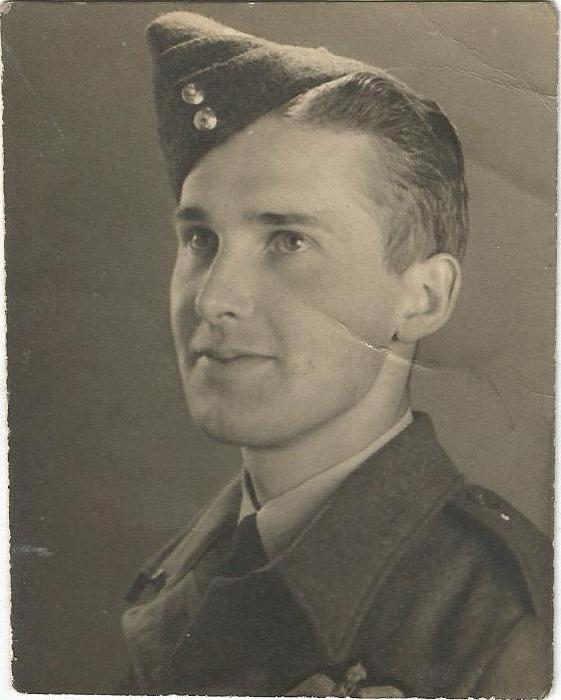 35 Hardey St, Invercargill, New
Zealand
35 Hardey St, Invercargill, New
Zealand
Born in 1923 to Nora and Alfred C Depree.
Alfred trained in Canada with the BCATP at the 2 Service
Flying Training School and then at 1 General Reconnaissance
School.
Sgt Depree found himself interned in Portugal on 17 June 1943 when he was forced to land his Spitfire aircraft while on a transit flight from Cornwall to Gibralter. It is understood he had been posted to a photo reconnaissance Squadron but this along with the identity of his actual Spitfire is unclear from the available records. His service file is equally confusing as multiple records refer to either 608 Squadron, 680 Squadron or 345 Squadron. He had been posted to RAF Benson in late April 1943 which was the headquarters of RAF photo reconnaissance operations. His various records list him as being posted to what is variously written as 1 OADU or 10 Aircraft Delivery Unit (ADU) on the 15 Jun 1943 and then to one of the Squadron level unit mentioned. Its seems likely that he was posted to the overseas unit at the time of his departure but with him going missing on the way, the posting details may not have reached Africa. He was most likely enroute to 680 Squadron which was flying PRU missions from Egypt at that time with Spitfires. 608 Squadron was at that time based at Blida in Algeria but flying twin engine Hudson patrol aircraft. His escape and evasion report and just one file in his service records state that his unit was "345 Squadron (Coastal Command)", however that unit was not actually formed up at that time and would not do so until January 1944, and then as a Free French fighter unit.
The reference of his escape and evasion report is MI9/SPG: 1399
245 Sqn (A B Depree RNZAF). In this he recorded that he
had departed Portreath at 9:30 in the morning of of 17
June 1943. He was bound for Cairo via Gibralter. He
experienced trouble with his aircraft and had to force land it
in a fields six miles north of Estremoz in Portugal.
between June 17th and 26th July he was interned by the
Portuguese government in the town of Elvas. He
broke an arm and a leg in the Irish crash. He remained in
Tralee hospital for three weeks and was then sent to Halton
hospital before being discharged on sick leave on September
11th. He is quoted in D MacCarron's book, page 91,
describing his memories of the crash. “The 'Sunderland episode' started for me
when I was flying a Mark XI Spitfire out to the Middle East
via Gibraltar and was forced to crash-land in
Portugal. I was interned with a few other aircraft,
and after about three weeks in the luxury Elvas Hotel in
Lisbon, during which we had he freedom of the city, we were
allowed to go home. We boarded the BOAC Sunderland
'ES' which was on a routine flight from the Middle East to
England with servicemen and civilians.
We took off from Lisbon at night, and I slept peacefully until we apparently arrived over Foynes in cloud in the early dawn and flew back out to sea to reduce height before returning below cloud level. My seat was immediately below the wing, and I climbed up on it to have a good look out the porthole but I could not even see the wing-tip float directly out from me - only solid mist rushing by. I was sure we were diving off height, an uncomfortable feeling when another pilot is doing it.
Suddenly there was a break in the mist and I not only saw the wing float but also, immediately below, the dark outline of land sloping the way we were going. At the same time the pilot put all four engines through the throttles gate, and I thought 'This is it!'. When I came to, I was lying half embedded in mud and slush with the aircraft burning around me in the misty murk and I slithered and crawled away from the wreckage".
His parents were sent a telegram from the NZ Ministry of
defense on 31st July 1943 reading:
Dear Mr Depree,
Further to the telegram sent to you by the Hon. the Minister
of Defense concerning your son, Sergeant Alfred Brooker
Depree, I have to advise that information received from Air
Ministry states that your son was traveling as a civilian in
a flying boat which crashed in Eire on the 2th. July
1943. Sergeant Depree received injuries consisting of
a fractured fore arm and leg. he has been classified
as not seriously injured. He was admitted to the St.
Catherines County Hospital, Tralee, County of Kerry,
Eire. Sergeant Depree was traveling as a civilian as
he was returning from internment in Portugal.
For reasons given above Air Ministry
have requested that you treat the above information as
strictly confidential.
They had only received telegrams and letters in June to say he
was, at first classified as missing on a transit flight from
Portreath, UK, to Gibraltar and five days later, that he was
interned in Portugal!
While he recovered from his injuries, he did not return to
active service and did not fly again operationally. He
remained in the UK recovering from August 1943 to June 1944,
spending many months in various plaster casts, when it was
agreed he would be unable to fly operationally and he was posted
back to New Zealand, allocated to the Air Force reserves and
demobilized.
Fred, as he was known to family and friends returned to his
native New Zealand where he passed away aged 70, on 13 August
1993 in Dunedin. He studied post war and became a
solicitor.
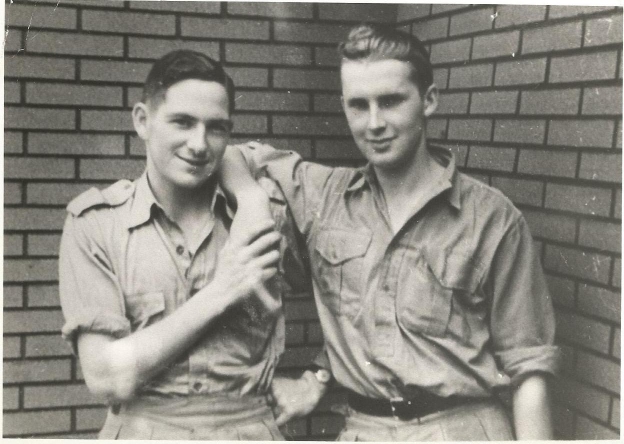
In the photo above, Alfred (right) is shown with an unknown serviceman.
William Sacheverell HEBDEN (Group Captain, 26109, Royal Air Force)
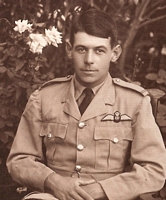 Hatfield Farm, Bordon, Hampshire
Hatfield Farm, Bordon, Hampshire
Chief Signals Officer, HQ Transport Command, having started journey in Cairo according to contemporary newspapers. He did not tell much of his experiences to his family but did recall the actions of those who climbed to the crash site. The photo shows him in the 1930's. Wartime shipping records on Ancestry.com show that he had passed through Foynes almost exactly one year before the crash, on July 25th 1942, traveling on the American Export Airlines Vought Sikorsky VS44, NC41881 from Foynes, via Botwood to New York. This was on his posting to the US as a signals liaison officer.
Flight Magazine of 16 January 1953 published this notice upon W S Hebden's appointment to new command.
No. 63 Group A.O.C.
UNTIL recently Director of Flying Training at the Air Ministry, A. Cdre. W. S. Hebden has been appointed A.O.C. No. 63 Group, Home Command.
A. Cdre. Hebden served with the Advanced Air Striking Force in France at the beginning of the war and later commanded No. 109 Squadron. After a period in the United States on signals liaison duties he was made Chief Signals Officer of the then newly-formed Transport Command and in 1945 commanded a transport wing in the Mediterranean.
109 Squadron served as an air intelligence unit and was tasked with airborne interception of German radio signals and the development of radio guidance systems for the growing bomber force. He transferred out of 109 Squadron on 5 December 1941 to the RAF Staff College as an instructor.
Born in 1909, William Hebden passed away in 2003 in Surrey. The photo, provided by his family, shows him in the 1930’s in India on an occasion when he won a skiing competition.
Mr Thomas WATSON THOMSON
1232 Park St, Hatfield, Pretoria, S. A.
The Guardian Newspaper of July 30th names Mr. Thomson as being
a colleague of Mr. Milner on a mission for the South African
Director of Supplies. References to this man refer to his
surname being Thomson or Watson-Thomson. An obituary for
Lewis Milner, the other South African on board recorded Thomas
as follows:
Mr. Milner's colleague on the mission,
Mr. T. W. Thomson, who is among the injured, is a railway
engineer in Pretoria and (missing word) seconded to machine tool (missing
word)
His wife is named as Mrs Alice Mary Thomson. He was
visited in Kerry while recuperating by a member of the South
African government stationed in London and his injuries kept him
in hospital as last as the 16th of August 1943.
A man named as T W Thomson, aged 35, is found leaving Cardiff
in December 1943 on the SS Umtali bound for for Cape Town.
No personnel address is provided but he his listed as a
government official care of (c/o) the South African High
Commissioner.
It seems probable that Thomas was born in September 1908, and
died in Boksburg in the summer of 1989.
Raymond Francois LARCHE (Corporal, R/91611, Royal Canadian Air Force)
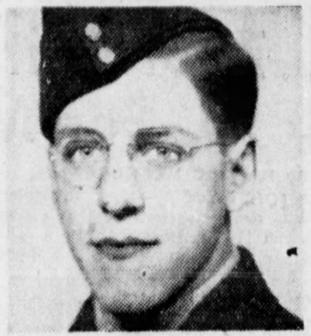
Raymond came from Transcona, Manitoba, Canada and was born 1
October 1920 to Louisa and Alfred Larche. He enlisted in
Winnipeg, Manitoba, 22 January 1941 as an Airframe Mechanic and
was posted overseas in January 1942. He was a member of
ground crew flying as a passenger on Wellington HE268 of RCAF
425 Squadron during the units transfer to North Africa. As
recounted elsewhere on this page, the bomber was damaged in
combat with a Luftwaffe heavy fighter over the Bay of
Biscay. He was forced to abandon the aircraft over
Portugal. He is mentioned in Lloyd French’s escape and
evasion report as being treated in the Portuguese military
hospital in Oporto. He traveled to Lisbon at the same time
as Lloyd French. French mentions him sustaining head
injuries in the G-AGES crash. He was repatriated to
Canada, 23 September 1944 and discharged from RCAF on January
9th, 1946.
The UK National Archives file, AVIA 2511 file describes
him as being RCAF and having the rank of Corporal. The
photo presented to the left was published in the Winnipeg
Tribune on June 17th, 1943 reporting his internment in
Portugal. The text read: Word
has been received by Mr. and Mrs. F. Larche,
Victoria ave., Transcona, that their youngest
son, L/AC. RAYMOND LARCHE. R.C.A.F., was
interned in Portugal June 4 after being
slightly wounded when his plane was forced down.
Another brother, Sgt. Armand Larche was killed
overseas last November, and two other
brothers are serving, Sig. Eugene. Larche
overseas, and PO. George Larche, R.C.N.V.R., in
Newfoundland.
Raymond’s nephew Ronald Larche provided a copy of this news article from the Winnipeg Free Press, printed on November 18, 1942, relating the fact that Raymond was one of four brothers who served during the war. His brother Joseph Armand Larche was killed on active service in November 1942 with Bomber Command.
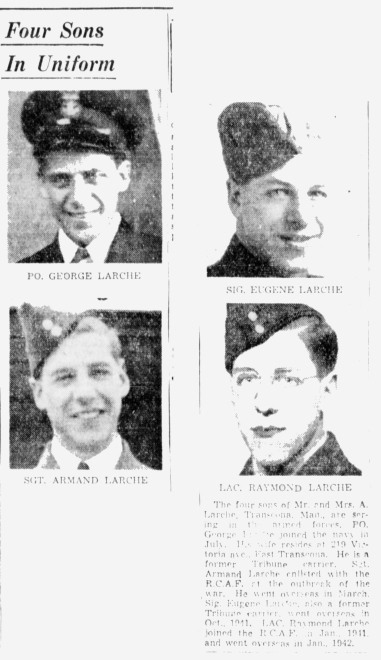 The Winnipeg Tribune of 30th October
1942 printed the adjoining article about the Larche brothers
service to Canada. Armand would lose his life within days
of this being published.
The Winnipeg Tribune of 30th October
1942 printed the adjoining article about the Larche brothers
service to Canada. Armand would lose his life within days
of this being published.
“The four sons of Mr. and Mrs. A Larche, Transcona, Man., are serving in the armed forces. PO. George Larche joined the navy in July. His wife resides at 219 Victoria ave., East Transcona, He is a former Tribune carrier. Sgt. Armand Larche enlisted with the R.C.A.F. at the outbreak of the war. He went overseas in March. Sig. Eugene Larche, also a former Tribune carrier, went overseas in Oct. 1941. LAC Raymond Larche joined the R.C.A.F. in Jan. 1941 and went overseas in Jan. 1942.”
Post war, Raymond took work as a machinist, a trade his father
also had. In later years, voter lists describe him as a
fitter or machinist. He moved to British Columbia in the
1960’s with his wife Kathleen.
Raymond passed away in Victoria BC. in Spetember 1987
Lloyd Gilbert FRENCH (Sgt., R/122777, Royal Canadian Air Force)
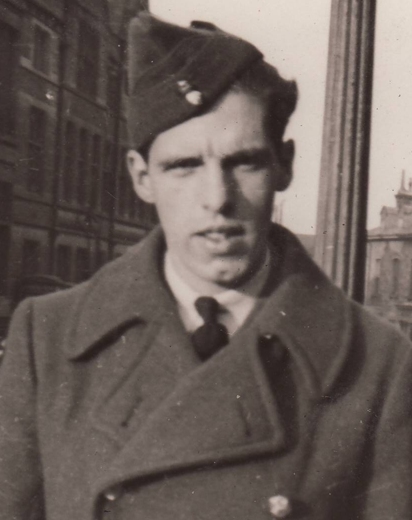
Address from BOAC report: 4 West View, Harrowgate, (Wife);
From Burford, Ontario.
He was born on 20 September 1917 to Charles and and listed as
a teacher by profession. He enlisted in the RCAF in
Hamilton, Ontario on the 16th August 1941 and following training
as a navigator was sent overseas in July 1942. He attended
23 Operational Training Unit before serving on active duty with
425 Squadron RCAF. The squadron was sent to North Africa
in Summer 1943. He and his crew mates, including
passenger, Raymond Larche, baled out of their aircraft,
Wellington HE268, near Esmoriz, Oporto, Portugal on June
4th. he had been injured by cannon shells in both
legs and was caught in trees upon landing. He and Raymond
Larche were looked after in Oporto military hospital until July
26th. Lloyd told his family that a German doctor there
wanted to amputate his leg but it was arranged that he would be
repatriated to England. He traveled to Lisbon on July 26th
and ended up on G-AGES. He describes in his evasion report
that he broke his leg and injured his head in the crash in
Ireland. He was taken to Tralee hospital and stayed
there until August 25th, when he left via Foynes for
Poole. His daughter mentioned that his injuries effected
him for many years and she remembers him having sleepless
nights.
The image below shows Lloyd with his new wife, Mollie in front
of the Regal Cinema in Harrogate. He married in
Knaresborough in 1943 prior to his departure for the
Mediterranean.
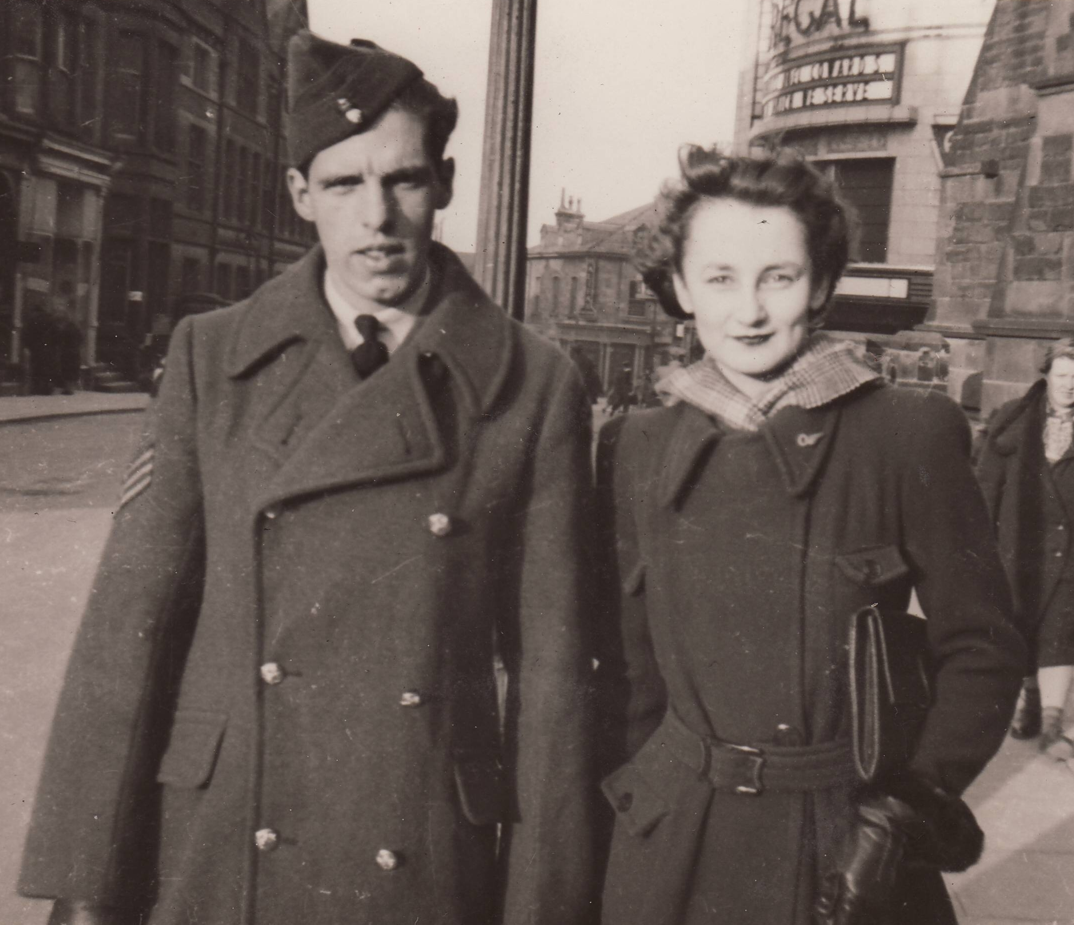
His experiences of 1943 were widely covered in Ontario
newspapers, from his wedding in June, followed closely by his
being injured over Portugal to then being injured in a further
plane accident. At the time of his arrival home in April
1944, the Expositor newspaper in Brantford, published a long
article and photo with his mother. The text is presented
below.

Brant's Luckiest Flier, FO. French,
Back Home
BRANT COUNTY'S LUCKIEST FLIER, Flying Officer Lloyd
(Lucky) French, 26. son of Mr. and Mrs. Charles S. French,
Burford, is back home, scarred and limping a little, but
generally in good condition, according to his own report.
FO. French came through alive after a parachute jump (over
Portugal) with both his
legs shot through and a
wound in his right foot. He came through alive a second time
when the plane he was in crashed and killed ten.
He didn't get a nick on 15 bombing
raids on Germany in which the plane he was on was hit by
flak more than once. He had gotten in his 15 trips on his
scheduled "tour" of 30 or more when he was given an
assignment, on a bright day last June that was a special
job. The crew was in high spirits about the assignment and
started away. A Junkers 88 so badly damaged the plane after
a few hours from base that all the crew had to bail out and
French among these, was in no shape to even walk. He had to
hobble to the escape hatch and tumble away from the plane.
The crew of the plane included Flying Officer R. J. Lacerte,
Edmonton, the pilot; Flying Officer (now squadron leader)
"Bunny" Shaw a bombardier of the R.A.F., and LAC. Ray
Larche, Winnipeg. Shaw was the hero of the piece. He absolutely refused to leave
French. When French went over the side. Shaw followed
him. He kept as close as he could in order that he would be
able to give French a hand when French hit the ground.
"There was a real guy," French said.
"Nobody saw the
enemy plane come at us but the rear gunner."
French observed"
The first indication we got there was anything wrong was a
correction from the gunner, 'hard right.' I was sitting at
the navigator's table. Next thing I knew I was hit. The
Junkers fired both cannon and machine gun at us. I was hit
in both knees and my right foot, Larche was hit in the seat
of the pants. He was not seriously hurt.
"Our pilot got out of that quickly and
ducked into clouds. We lost our attacker. I didn't
immediately say anything about being hit. We were some
distance from land and I wanted to straighten things out
about our course. A few minutes later I told them what
happened to me. I was bandaged up in the plane.
"The ship was badly damaged. We had only one
motor but we managed to stay up about two hours and a half.
We got over land all right and were ordered to bail out, two
at a time. I thought of many things, home and wife. I had
just been married a month before.
"When I jumped, 'Bunny' Shaw went with me to look
after me. We landed about a mile apart. We both had
whistles. I blew. He blew an answer. It took him about five
minutes to reach my side. He ran all the way."
DOWN IN WOODS
FO. French came down in a woods. His parachute caught
in a tree and he hung there. The pain, he said, "wasn't
enough to make me faint, but it was bad enough. I had lost a
lot of blood." He managed to cut himself down and fall on
his injured legs.
Natives of a town a few miles away rushed to the scene.
"They had seen us coming down," French stated. "We
could see them coming toward us. 'Bunny' started to carry
me. Three fellows came out of the crowd and took over the
job.
Two of them made a 'swing' with their hands and the
other carried my feet. It took us two or three hours to make
the town.
They wanted us to have something to eat before I was
taken to the hospital. A great crowd had gathered."
SECOND PLANE CRASHES
For almost eight weeks he was in hospital. Authorities
then permitted him passage back to Britain. He boarded a
plane last July 28 with 24 other passengers. Near home, the
plane crashed into the side of a mountain.
"I was looking out a window We were only about 1,700
feet up," French said. "Next thing I knew I was lying on a
mountain side. Ten in the plane, including the pilot, had
been killed. Somebody apparently had carried me from the
wreck. My right leg, which had not completely healed from
the wounds, was broken in two places. My face and head were
cut. It took 14 stitches to close the wounds in my head.
"One of our fellows went down the mountain to get aid.
When it came, we were carried down the mountain and I went
into hospital again. I was there nearly six months. For four
months I was on crutches."
French's only visible scars now zig-zag about his right
eye.
He said some of his most thoughtful moments came when
he was wounded in the plane and knew he had to jump.
"You thought, perhaps, 'This is it?' " he was asked.
"I did," he answered.
His British bride and their youngster are coming to
Canada soon.
FO. French is a graduate of the Fingal bombing and
gunnery school. In his 15 raids on Germany his plane
attacked some of the most difficult targets, including
Essen, Kiel, Wilhelmshaven and Cologne.
He returned to Canada in April 1944 and was released from the
service in October. He attended University after the war
and worked with a shipping company until his retirement in
1983. Lloyd died 1998 and is buried in Burford,
Ontario. He has three proud daughters Anne, Anita and
Wynne. His nephew Lloyd Holland very kindly provided
wartime images and article of Lloyd.
Passengers - Origin (From AVIA 2314)
Lagos Africa
1. Mr D W Stannard RAF - Returning from Inspection Tour
2. Mr J D Hartigan RA - Returning from recuperation after being
wounded.
3. Mr A F R Lumby Army - Returning from posting with SOE in Gold
Coast.
4. Mr W S Hebden RAF - Returning from duty in the Mediterranean,
RAF Transport Command.
5. Mr L Milner Civilian - On business for the South African
government.
6. Mr S L Pullinger British Army, RE returning home on leave.
7. Mr I K Thom Civilian- Returning from India with the De Le Rue
company
8. Mr H Tristram Civilian - Returning from India with the De Le
Rue company
9. Mr T Watson Thomson Civilian - On business for the South
African government.
Lisbon
10. Mr K Devall RAF Former Portuguese Internee
11. Mr L King RAF - Former Portuguese Internee
12. Mr V Simmons RAF - Former Portuguese Internee
13. Mr O Frith RAF - Former Portuguese Internee
14. Mr. A B Depree RNZAF - Former Portuguese Internee
15. Mr M A Roth - Swiss Government
16. Mr. L G French RCAF - Former Portuguese Internee
17. R E Bertram RAF – Former Portuguese Internee
18. R F Larche - RCAF - Former Portuguese Internee
Commonwealth War Graves Commission Entries - www.cwgc.org
Of the 10 men killed, only six have burial details recorded
and administered by the Commonwealth
War Grave Commission. Allitt, Lumby, Devall,
Pulinger, Stannard and Hartigan were all serving members of the
UK Armed Forces at the time of their deaths, though their
presence on a "civilian" airliner does cause some confusion as
to their status. Max Roth was of course a Swiss national
and not eligible for inclusion in CWGC records. Thom,
Milner and Tristram were civilians and were not killed due to
enemy action or while flying on a service aircraft, thus they do
not appear on CWGC records. They were engaged on work
related to the war but outside of the remit for CWGC inclusion.
Name: ALLITT,
THOMAS
Rank: Flight Lieutenant (Pilot)
Regiment/Service: Royal Air Force Volunteer Reserve
Seconded to British Overseas Airways Corporation
Age: 32
Date of Death: 28/07/1943
Service No: 77029
Additional information: Son of William and Harriet Allitt;
husband of Margaret Mary Allitt, of Liverpool.
Grave/Memorial Reference: Sec. 2. R.C. Grave 974.
Cemetery: LIVERPOOL (KIRKDALE) CEMETERY
(The entry below was on the CWGC database but was removed
during 2010 during a tidying up of Commission records leaving
only the entry above. The information remains in older
printed registers of Civilian casualties.)
Regiment/Service: Civilian War Dead
Date of Death: 28/07/1943
Additional information: of 14A Walton Park, Liverpool. Husband
of M. M. Allitt.
Reporting Authority: AIR CRASHES AT SEA
Name: LUMBY,
ARTHUR FRIEDRICH RAWSON
Rank: Colonel
Regiment/Service: General Staff
Unit Text: Commands and Staff
Secondary Regiment: 2nd Punjab Regiment
Age: 52Date of Death: 28/07/1943
Awards: CIE, OBE
Additional information: Son of the Revd. Joseph Rawson Lumby,
D.D. and Luise Lumby; husband of Lettice Mary Lumby (nee
Hodgkinson), of Askerswell.
Cemetery: ASKERSWELL (ST. MICHAEL) CHURCHYARD, N.E. corner of
churchyard.
Name: DEVALL,
KENNETH JOSEPH
Rank: Sergeant (Nav.)Regiment/Service: Royal Air Force Volunteer
Reserve
Age: 20
Date of Death: 28/07/1943
Service No: 1577068
Additional information: Son of Frank Clift Devall and Florence
Adelaide Devall, of Dudley.
Grave/Memorial Reference: Plot D. Grave 950.
Cemetery: DUDLEY BOROUGH CEMETERY
Name: PULLINGER,
SIDNEY LEONARD
Rank: Colonel
Regiment/Service: Royal Engineers
Date of Death: 28/07/1943
Additional information: Son of Sidney Abraham and Maria Rebecca
Pullinger, husband of Irene Pullinger, A.M.lnst. M. and Cy.E.,
A.I.A.A.
Grave/Memorial Reference: S.E. Corner.
Cemetery: KILLINEY CHURCHYARD
Name: STANNARD,
DAVID WILLIAM
Rank: Group Captain
Regiment/Service: Royal Air Force
Age: 34
Date of Death: 28/07/1943
Additional information: Son of William and Mary Stannard;
husband of Ursula Stannard, of Surbiton, Surrey.
Grave/Memorial Reference: S.E. Corner.
Cemetery: KILLINEY CHURCHYARD
Name: HARTIGAN,
DIARMUID JOHN
Rank: Captain
Regiment/Service: Royal Artillery
Unit Text: 22 Mountain Bty.
Age: 27
Date of Death: 28/07/1943
Service No: 69053
Additional information: Son of Dr. John Hartigan and Ethel J.
Hartigan, of Badgworth, Somerset.
Grave/Memorial Reference: Plot 5.
Cemetery: BRUFF CATHOLIC CHURCHYARD
The communal burial plot in Killiney cemetery, Co. Kerry.
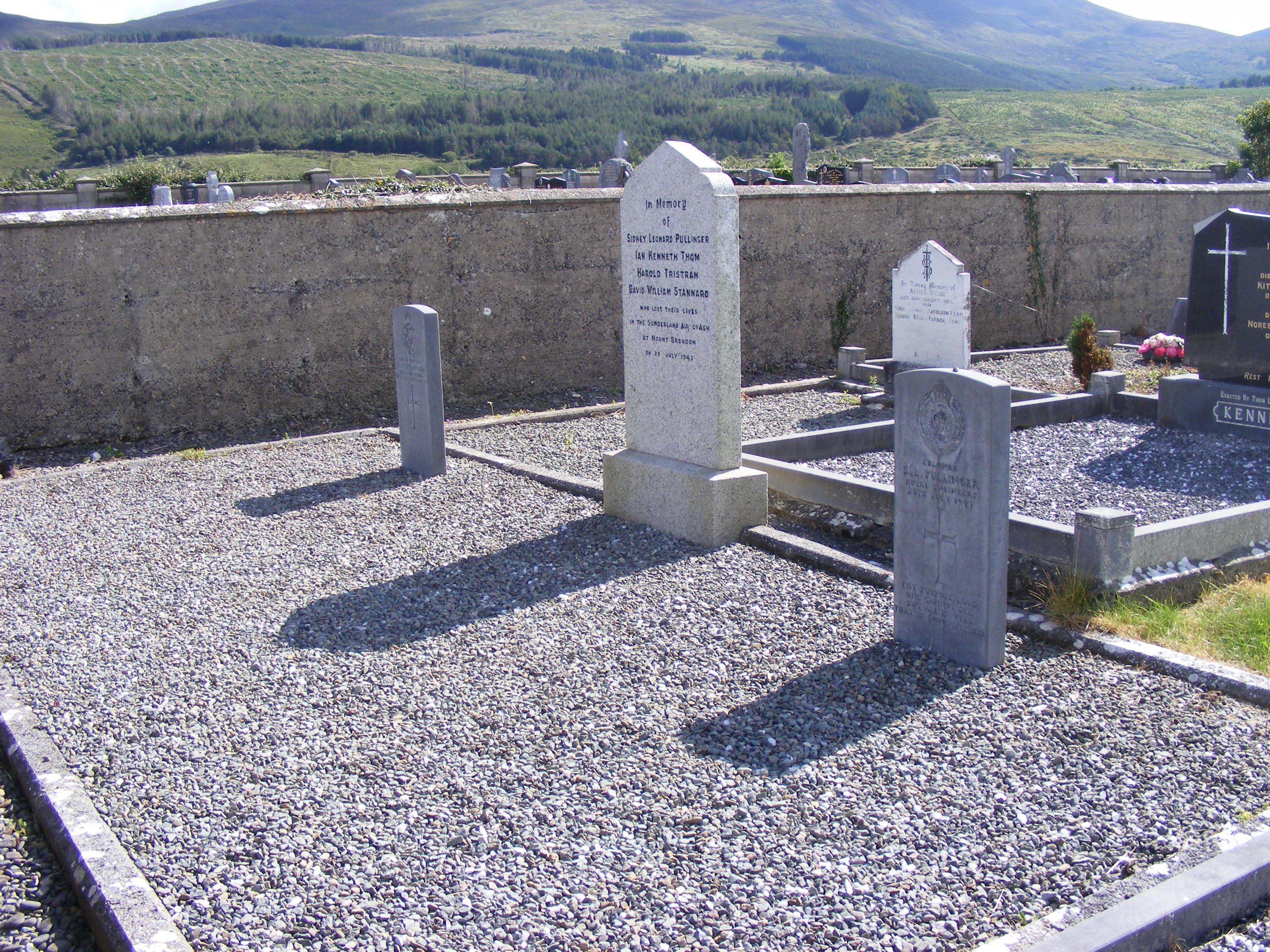
Aircraft History
G-AGES was one of a batch of six Sunderland Mark III flying
boats built at Rochester and delivered in standard BOAC
Camouflage and fitted from production with austere bench
seating. All turrets had been removed. It was part of an batch
of aircraft intended for the RAF and was to have been Short
Sunderland JM661 but upon delivery to BOAC was registered with
the civilian marks, G-AGES. The other five aircraft were
G-AGER, G-AGET, G-AGEU, G-AGEV and G-AGEW
G-AGES was registered 12 Nov 1942 (Certificate of Registration No 9375)
First Flight 31 Dec 1942 for B.O.A.C
Delivered 15 Jan 1943, Certificate of Airworthiness 19 Jan 1943 (Number 6953) to BOAC (unnamed)
Entered service 28 May 43 as JM661 coded "OQZS"
(Jon Lake, Sunderland Squadrons of World War 2, Osprey, 2000)
(D. King - Air Britain Historian)
Foynes Museum Displays
The Foynes Flying
Boat Museum display. This presents one of the
aircrafts engines along with a battered section of wing tip
float.
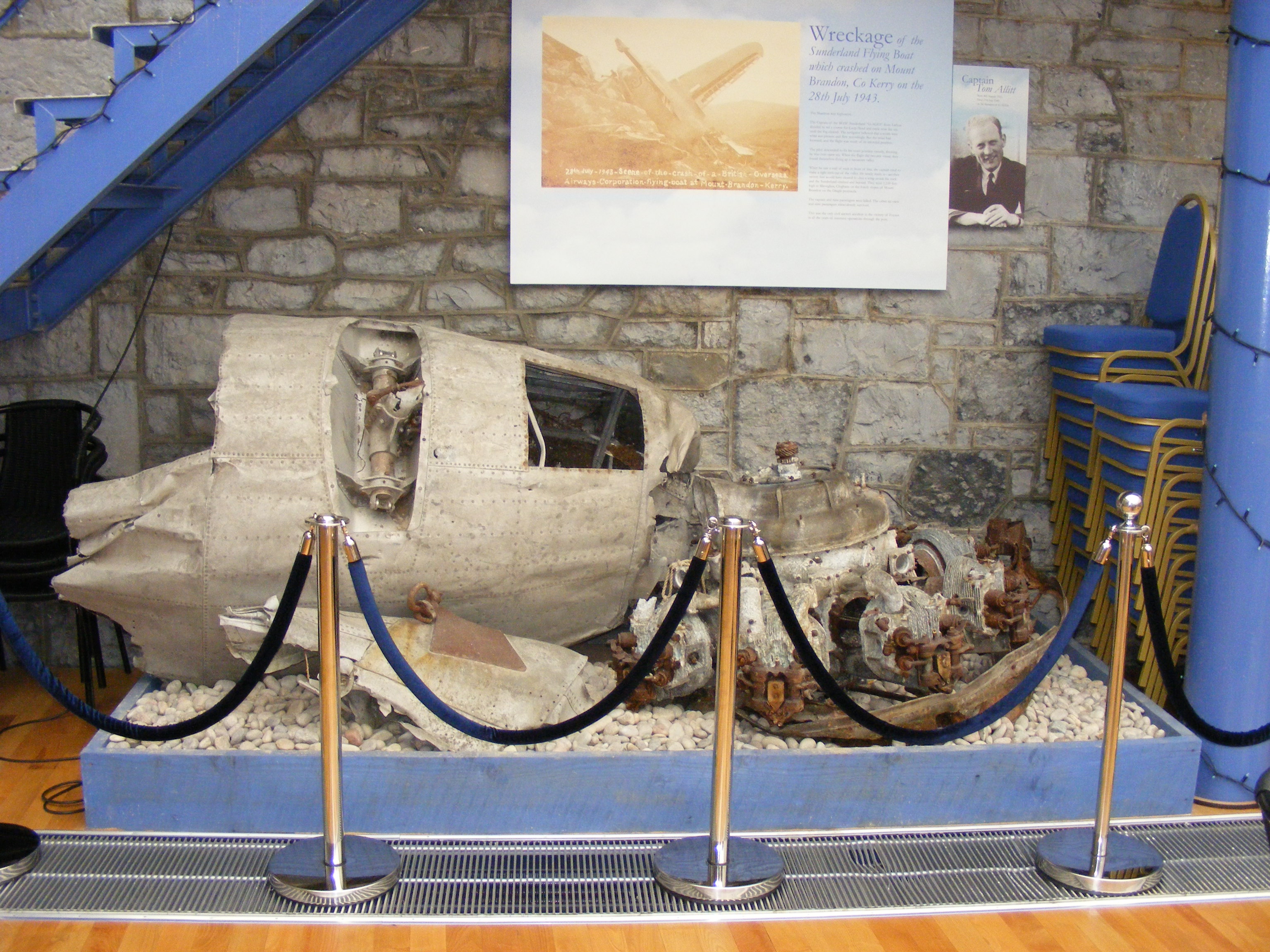
In the museum they have this sample of one of the prisoner of
war post cards which were being flown to England on G-AGES as
well as the background to the individual card.
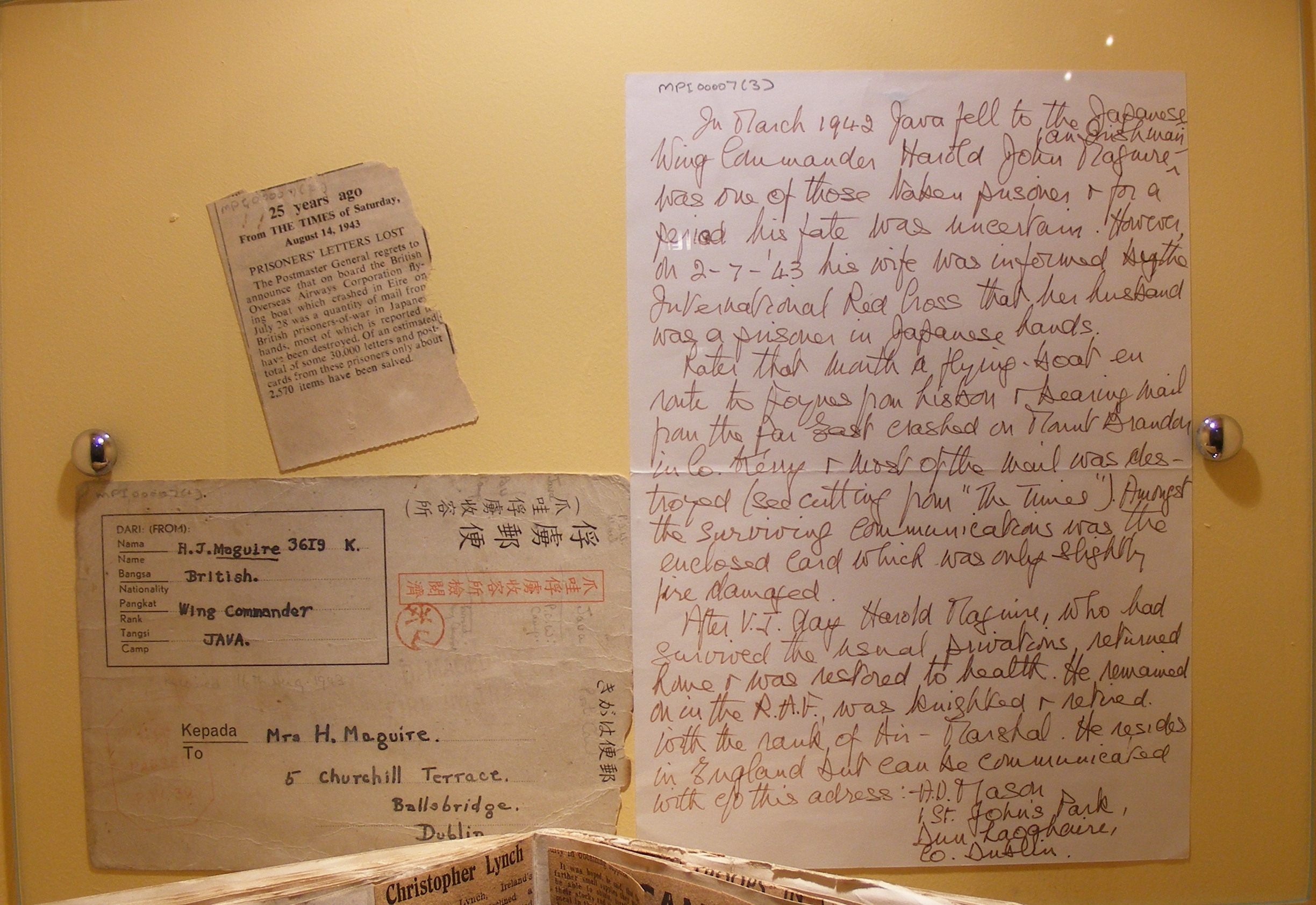
Summary of the Official B.O.A.C. Enquiry Report
This report is held by the British Airways Museum.
ALL TIMES REFERRED TO IN THIS REPORT ARE GREENWICH MEAN TIME
PREFACE
The S.25 type Sunderland flying boat G-AGES left Lisbon at 2115 hours on service 20W223 Lagos- Foynes on the 27th July 1943.
There were 18 passengers and the following crew:-
Captain T. Allitt (in command)
Second Officer J.H. Slater
Navigating Officer E.W. Vincent
Radio Officer C.H.P. Phillips
Radio Officer P.T.J. Parr
Engineer Officer V. Rawlinson
Engineer Officer R.B. Lawes.
At 2341 hours the Captain informed Foynes that he expected to arrive at 0415 hours on the 28th July and that he intended following the Loop Head route. The aircraft arrived over the Shannon Estuary and turned on a course of approximately 090° at about 6,000 feet in clear weather above 10/10ths cloud. At about 0400 hours the aircraft signaled that it was over EIP Radio Station and that it was proposed to alight after 45 minutes, the intention presumably being to wait until the light had improved and meantime to fly out to sea.
The Captain instructed the Second Officer, who was at the controls, to alter course to 270°. After about 19 minutes the Captain took over the controls, disengaged the "Auto Pilot" and started to descend at approximately 800-1,000 feet per minute indicated. Suddenly the ground was seen in close proximity, although the aircraft was still flying in cloud. The Captain levelled out the aircraft, opened the throttles to full power and ordered "Fully fine". The Second Officer obeyed the order, the Captain pulled back the control column in an attempt to climb. About 4 to 5 seconds later the aircraft crashed on Slieveglass, (approximately 2,000 feet), Dingle Peninsula, Co. Kerry. The aircraft was steering a course of approximately 260°M.
It appears that the starboard wing struck the mountainside first causing the starboard outer engine to fall out. The aircraft skidded about 50 yards and slewed round to starboard so that it came finally to rest broadside to the slope of the mountain against boulders. The aircraft caught fire, which started in the port wing.
The second officer extricated himself and the two Engineering Officers escaped through the emergency hatch at the top of the fuselage. They then pulled clear of the burning wreckage as many men as they could find until the bursting of the main fuel tanks prevented further rescue efforts. The heat of the fire reduced the aircraft to a mass of molten metal. The Captain and nine passengers were killed. The remaining occupants of the aircraft were injured.
(The National Archives, UK; BA Museum, Courtesy of M. Gleeson.)
Incident Report of the Irish Department of Industry and Commerce.
This summary report is found within the BOAC file.
Report issued by the Department of Industry and Commerce following a Preliminary Investigation by the Inspector if Accidents into an accident to the British Overseas Airways Corporation aircraft G-AGES on Brandon Mountain, Co. Kerry
The aircraft involved was type Short S.25, with registered markings G-AGES, the property of British Overseas Airways Corporation and was engaged in a scheduled flight to the Shannon Airport from Lisbon, Portugal. The accident occurred at approximately 4.30 G.M.T. on July 28th, 1943, on Brandon Mountain, Co. Kerry. The flight from Lisbon proceeded without any particular incident except that the south-west wind which was encountered was of greater strength than expected and the aircraft arrived above cloud over Foynes thirty minutes before the estimated time of arrival it had earlier signaled. Having established his position over Shannon Radio Station, the Captain decided to return to Loop Head in order to expend 45 mins. until there should be enough light for landing. After turning over the Radio Station, the aircraft descended to a lower level. The navigating personnel aboard assumed that the south-west wind which had been experienced up to that time was still present and made allowances accordingly in calculation. It is no known from the deduced weather conditions that the actual wind speed and direction at 2,000 ft. were 30 knots and north-westerly. This wind had not been forecast and was not known at the time to the Duty Forecaster at Foynes who was not in any case, aware of the aircraft's intention to fly to Loop Head. As the aircraft had reported no difficulties during the flight and as conditions at Foynes were deteriorating, the Forecaster had applied himself to watching local conditions in preparation for the landing. The north-westerly wind caused the aircraft to descend through the cloud to fix his position in the belief that he was in the vicinity of Loop Head, he was actually near Brandon Mountain. The high ground was seen through the cloud mist, but, in spite of an attempt to climb, the aircraft struck the mountain side, crashed and burned.
A crew of seven was carried in the aircraft and there were eighteen passengers. The Captain of the aircraft and nine passengers were killed. Nine other passengers were injured. The Captain held a current commercial licence and the aircraft was covered by a valid Certificate of Airworthiness.
Navigation for the flight west from Foynes was by compass and loop bearing on the ground radio station and there was no request from the aircraft for QTE bearings to be transmitted from the radio station. If it is assumed that the aircrafts loop bearing on the radio station was free from error, the alteration in the aircraft's track should have been immediately apparent by a change in the compass course. Alternatively, if the course remained constant the alteration in track should have been indicated by a change in the loop bearing. The departure from the required track was not discovered by the crew and the reason for this is not conclusively evident. Radio direction-finding apparatus of the type used on the aircraft is subject to error around sunset and sunrise. The presence of this error, known as “Night Effect” cannot always be detected, even by experienced radio operators. The probable final cause of the accident was “Night Effect” which affected the accuracy of the direction-finding apparatus on the aircraft. The contributory cause sof the accident may be summarised as follows: -
(1)A strong south-westerly wind which resulted in the aircraft's arriving at Shannon Airport thirty minutes before its scheduled time of arrival.
(2)A change in wind direction from S.W. To N.W. in the Shannon area around the actual time of arrival.
(3)The pilots error in technique in relying entirely on the aircraft's loop bearings for radio assistance to the exclusion of direction signals from the ground station.
Media Reports from Contemporary Newspapers and Magazines
There follows a selection of newspaper and magazine articles
published in 1943 and 1944 that dealt with or touched on the
crash.
The Kerryman - 31st July 1943
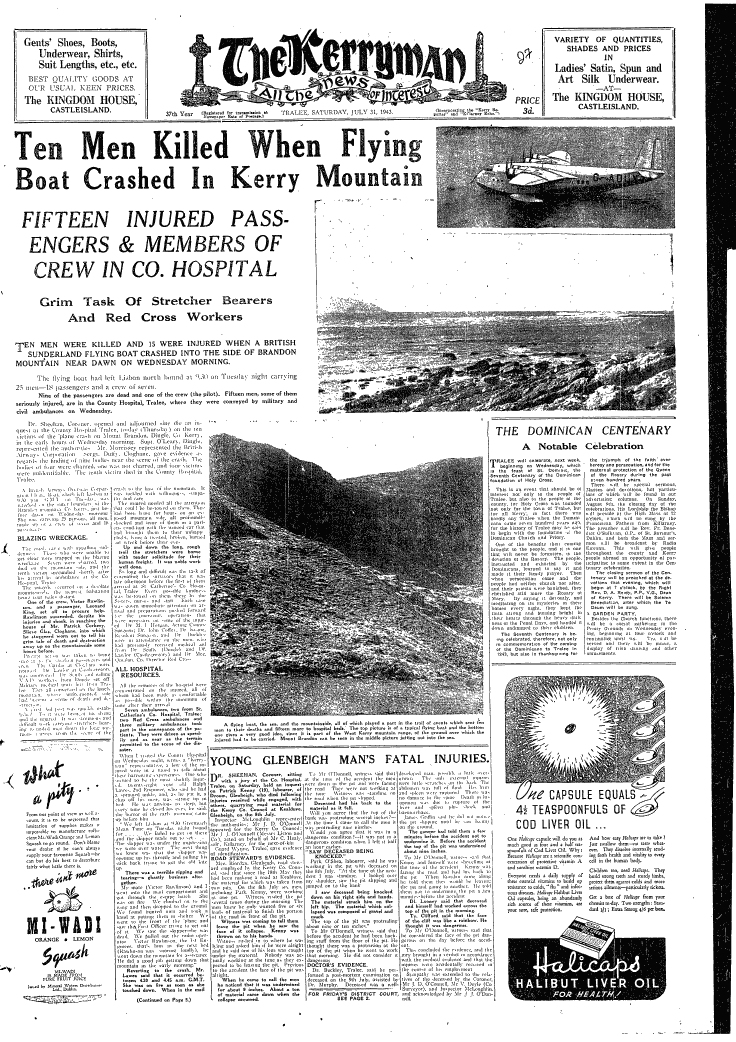
The Irish Times - 29th July 1943
Ten Killed in Air Accident in Kerry
A British Overseas Airways Corporation flying-boat, north-bound from Lisbon, crashed into the lonely slopes of Mount Brandon, Cloghane, Castlegregory, Co. Kerry, in the early hours of yesterday.
Crashed into mountain
When Patrick Corkery, Sliabh Glas, awakened by banging, got up and opened the door of his mountain cottage in the early hours of the morning, a strange-looking, over-alled figure stumbled into his kitchen and collapsed on a chair. The man had just enough strength left to tell the cottier of the terrible thing that had happened further up on the mountain, the sudden crash, the explosion, and, in the light of the burning wreckage, the bodies inert on the stone-covered ground; the frantic rescue efforts, the dragging of the stunned passengers away from the blaze, and the wandering through the swamp and heather till he found the house.
Making swiftly for the village of Cloghane, Corkery notified the Guards, and police and miltary with a Red Cross unit from Dingle climbed the mountain to the help of the injured. Later in the morning their efforts were supplemented by members of the Tralee branch of the Red Cross, and those who were seriously hurt were taken down the mountain on stretchers and transferred to Tralee Hospital.
"When we got to the remains of the 'plane we saw bodies strewn over a wide area, as if they had been blown out of the machine." one of the helpers told an Irish Times reporter. "it was horrible to go up there. Our people were succoring several of the injured who were conscious, but were too weak to walk. Many of the dead passengers were charred and unrecognisable."
Tributes were paid by members of the crew to the work of the Red Cross, with nurse P. J. Devane and Dr. Geo. Scully, Dingle, and Dr. Lawlor, Castlegregory, who set up a First Aid post on the mountain with the help of the local L.D.F.
The machine left Lisbon at 10 p.m. On Tuesday, and carried a large quantity of mail from prisoners of war in Japan.
The dead and injured had to be carried three miles down the mountain-side to Cloghane.
The Irish independent - July 30th 1943
Kerry 'Plane Tragedy
SURVIVORS TELL OF MOUNTAIN CRASH
The inquest was opened and adjourned, sine die, at the Co. Hospital, Tralee, yesterday, on the ten victims of the flying boat crash at Mount Brandon, Dingle, early on Wednesday.
The following identifications have been established: -
Max Roth (33), married, a Swiss Government Courier between Lisbon and Washington; Thomas Allitt, captain and pilot of the aircraft; Kenneth G. Devall, Dudley North, Birmingham; Louis Milner, manager of E. W. Tarri and Co. Ltd., Simon St. Johannesburg; Diarmuid Hartigan, Nairobi, grandson of the late Dr. Hartigan, Tarbrook, Croom and Alfred Lumbi, Gipsy Lane, Headington, Oxford, who died in hospital.
The names of the injured in Tralee Hospital, with addresses so far available, are: -
Roy Bertram, Woodside, Brighton; Eric Vincent, India Avenue, Salisbury, Wilts; Victor Rawlinson, Commercial Rd., Parkistone, Dorset; Leonard King (22), Moffat Road, Maidenhead; John Slater, Rockwell, Bristol; Frederick Broker, Oliver Frith, Victor Symonds, Raymond Larch, Lloyd G. French, Thomas Thompson, Fred Parr, Charles Phillips, Ralph Lawes, and William S. Hebden.
STORY OF THE CRASH
The crash of the flying boat, which immediately burst into flames, was described in hospital by members of the crew. Seven of those killed were burned beyond recognition.
Ralph Lawes, second Engineer, said that when the 'plane struck the side of the mountain, he entered the mail compartment and pulled himself through and escape hatch and then climbed along a wing of the 'plane, which was by then fully ablaze to drop to the ground.
With other injured men he did what he could to assist those who had not escaped, and he helped out the first officer, John Slater, who was trying to extricate himself from the front of the machine.
Victor Rawlingson, first engineer, and a passenger, Leonard King, staggered down the mountain side for four miles before, in the breaking light, they found a house. The whole household turned out to their aid, having sent one of their members for a doctor and the police.
The first doctor to arrive had traveled 12 miles from Dingle, on the other side of the mountainous peninsula. The injured had to be conveyed nearly twice that distance to hospital at Tralee.
Capt. Allitt was 32. his wife lives in Liverpool. He had been with British Overseas Airways since 1938 except for a brief period in 1940.
The Times 30th July 1943
B.O.A.C FLYING-BOAT CRASH IN EIRE
NAMES OF THE KILLED AND INJURED
FROM OUR AERONAUTICAL CORRESPONDENT
It is now known that 10 men (not 12, as stated in the later editions of the The Times yesterday) lost their lives when a British Overseas Airways flying-boat crashed in dense early morning fog early on Wednesday morning in a lonely part of County Derry (sic), Eire. The machine hit the side of a mountain near the small seaport and market town of Dingle, some miles from Tralee, and burst into flames.
Some of the dead and injured were found more than 100 yards from the blazing aircraft; some were killed instantly and some were trapped inside. The next-of-kin have all been informed.
The aircraft had left Lisbon for Foynes on Tuesday night, carrying 18 passengers and a crew of seven. All the passengers were men, and were travelling on official business. Every one in the machine was injured, most of the seriously, and a number are detained in Tralee Hospital.
Those who lost their lives are believed to be: -
Mr. Max ROTH, 33, a Swiss Government courier between Lisbon and Washington
Mr. A.. F. R. LUMSY, of Headington, Oxford
Mr. L. K. THOM, of Potters Bar I Kenneth Thom on head stone
Mr. H. TRISTRAM, OF Strathendry, Fife Harold Tristran on headstone
Mr. K. DEVALL, of Dudley, Worchestershire
Mr. S. L. PULLINGER,
and three passengers from South Africa, Mr. P. W. STANNARD, Mr. D. HARTIGAN, and Mr. L. MILNER.
CAPTAIN THOMAS ALLITT, aged 32, of Liverpool, the captain and pilot of the aircraft, was also killed. He was the only crew member to lose his life.
The other members of the crew were: -
Second Officer (Acting F/O) JOHN SLATER, of Rockwell, Bristol
First Engineer VICTOR RAWLINSON, of Commercial Road, Parkstone, Dorset
Second Engineer RALPH LAWES, of Pontypridd
Sergeant E. W. VINCENT, the navigator, of India Avenue, Salisbury, Wilts (an Ex-RAF man who had been seconded to B.O.A.C. for the past year)
Radio Officer CHARLES PHILLIPS of Bournemouth
Radio Officer F. T. S. PARR of London
Details of those detained at Tralee Hospital, in addition to members of the crew, are as follows:-
ROY BERTRAM, Woodside, Brighton;
Pilot Officer LEONARD KING, R.A.F.V.R.; of Moffat Street, Maidenhead;
FREDERICK BROKER;
OLIVER FRITH; OF Portsmouth;
RAYMOND F. LARCHE; of Manitoba;
LLOYD G. FRENCH, of Harrowgate;
THOMAS W. THOMPSON, of South Africa;
and WILLIAM S. HERDEN.
The Irish Times and Irish Independent - Saturday, 31st July 1943
AIR CRASH VICTIMS BURIED
Six victims of the British Overseas Airways flying-boat's crash at Mount Brandon, Dingle, were buried yesterday in one grave at Killiney Cemetery, Castlegregory.
Four of the coffins bore no names. The other two bore the names of Louis Milner, Johannesburg, and Kenneth G. Devall, Dudley North, Birmingham. The body of Capt. Ellitt was taken to Liverpool yesterday morning.
Among the clergy officiating were Very Rev. W. O'Connor, P. P. Castlegregory: Rev. T. J. Smith, Rectory, Camp, Castlegregory; Rev. F. J. Roycroft, Rectory, Dingle; Rev. Canon Griffin, Rectory, Tralee.
The attendance also included: - Army, Major Leamy, Tralee; Dept. of Industry and Commerce, Col. P. Maher and Mr. Liston; British Overseas Airways, Messers. Morrissey and Watson; Shell Petrol Co., Messers Young, Riordan, Shaw and O'Reilly; Garda Siochana, Supt. O'Leary, Dingle; Sergt. Duffy, Cloghan; Red Cross, Dr. Scully and Dr. Lawlor, Mrs. Mulcahy, Mrs. Scully.
The Maidenhead Advertiser
MAIDENHEAD PILOT OFFICER'S BRAVERY
RESCUED PEOPLE FROM BURNING AIRCRAFT THOUGH INJURED..
A Maidenhead Pilot Officer, Leonard King, of the R.A.F.V.R. Whose mother, Mrs. L. King, is the proprietress of "The Waterloo" Cafe in Bridge Street, displayed conspicuous gallantry when rescuing injured people from a British Overseas Airways flying-boat which crashed in a dense fog early on Wednesday mornign in a lonely part of County Derry (sic), Eire.
The machine hit the side of a mountain near the small seaport and market town of Dingle, some miles from Tralee, and burst into flames.
Ten men lost their lives and the injured were found more that 100 yards from the blazing aircraft.
(See photo above)
The aircraft had left Lisbon for Foynes on Tuesday night, carrying 18 passengers and a crew of seven. All the pasengers were men, and were travelling on official business. Every one in the machine was injured, most of them seriously, and a number, including Pilot Officer King were detained in Tralee Hospital.
Pilot Officer King was the hero of the crash. Despite the fact that he was suffering from head and leg injuries , in staggered with Victor Rawlingson, the first engineer, three miles to the farm house of Stanley Corkerry and roused him.
Carried Injured down Mountainside.
Together they returned to the burning machine and carried injured people four miles down the mountainside to ambulances which were called by Corkerry's wife.
King, who was in need of medical aid, made several trips up and down the rocky cliff-like face with injured on his back. Corkerry asked him to stop and rest, but he carried on until stretchers were brought from ambulances.
Pilot Officer King's wife, who lives at 55, Moffat Street, received a telegram from the Air Ministry on Thursday informing her of what had happened and stating that he was in hospital suffering from head and leg injuries.
He was home on leave about six weeks ago, prior to going to going to the Middle East. He has taken part in no fewer than forty operational flights under Bomber Command.
He has a splendid record of service to his credit. When war broke out he was emplyed in the laboratory of High Duty Alloys, and as a volunteer reservist he was called for service as a sergeant pilot. Subsequently he became slight sergeant, warrant officer and then pilot officer.
Aged 22, he was born in Maidenhead. He attended East-street School, and passed his 11+ exam to go to the County boys School. He worked at High Duty Alloys when he left school. He was an amateur runner. At this time he is making good progress in hospital.
(Note: According to the official inquiry, while P/O L King did not carry any of the injured down the mountain himself he was commended for having made his way down the mountain having suffered head and leg injuries, he did find help and assisted in the notification of the authorities of the crash similar to Victor Rawlinson.)
The Times - 14th August 1943
MAIL LOST IN AIR CRASH
27,400 MESSAGES FROM BRITISH PRISONERS IN FAR EAST.
The Postmaster General regrets to announce that on board the British Overseas Airways Corporation flying-boat which crashed in Eire on July 28th was a quantity of mail from British prisoners of war in Japanese hands, most of which is reported to have been destroyed.
Of an estimated total of some 30,000 letters and postcards from these prisoners only about 2,750 items have been salved. The salved correspondence is being put into course for delivery as soon as possible.
The Postmaster-General expresses his sincere sympathy with relatives who, having waited anxiously for so long for news of men reported missing in the Far East theaters of war, have suffered disappointment though this unfortunate accident. The Protecting Power will be asked to take such steps as are possible to expedite further consignments of mail from the Far East.
From Flight Magazine, September 21st 1944, Page 317
WEST AFRICAN AIR CORPS
MANY hundreds of R.A.F. men now in West Africa will be released for service elsewhere when recruiting for the newly formed West African Air Corps is complete. Some have already been released by the employment of African civilians.
The first recruit was enrolled on the last day of January this year. Already nearly 3,000 have joined, and by the middle of next year the total is expected to be over the 6,000 ji mark. They will form part of the R.A.F. West African Command which, in conjunction with the Royal Navy, keeps open the central Atlantic shipping routes.
The scheme began as far back as 1942, when the Inspector-General of the R.A.F., after a visit to West Africa, strongly recommended the enlistment of Africans rather than their continued employment on a civilian basis.
In April, 1943, Group Captains D. W. Stannard and G. A. R. Muschamp undertook a tour of Africa from Gibraltar to Zanzibar and back to Cairo to investigate the potential field of employment. Group Captain Stannard was unfortunately killed in an air accident on the way back, but Group Captain Muschamp returned with the plan which six months later began to take shape.
Now Africans are enrolling for training as fitters, draughtsmen, carpenters, electricians and many other trades. Pay ranges from 1s. to 5s. 6d. a day according to trade and rank, besides a marriage allowance of 6d. a day and free food and accommodation. It is hoped that many of their trades will be useful to them after the war. One recruit has already gained the rank of flight sergeant.
Although many different tribes are represented among those who are joining the Corps, most of the recruits speak English, and this will be the common language. They are serving at Air Force bases in Gambia, Sierra Leone, Gold Coast and Nigeria. Among them are men who have fought with the Army in North Africa.
The Aircrew who were interned in Portugal.
Seven of the men on board G-AGES were returning from temporary internment in Portugal after they had to abandon or crash land their aircraft in another Neutral country, Portugal.
The first of these aircraft to arrive in Portugal was Vickers Wellington X, HE268 of 425 Squadron, Royal Canadian Air Force. 425 Squadron had been tasked to deploy from the United Kingdom to North Africa and take part in bombing operations in the Mediterranean. On June 3rd, 1943, 20 aircraft from the squadron took off from Portreath for Gibraltar. All aircraft reached their destination with the exception of HE268 flown by P/O Rudolph J Lacerte. About two and a half hours into their flight, out over the bay of biscay, they were attacked by a Luftwaffe heavy fighter. The aircraft was damaged and began to loose fuel. As a result of the attack, two of the men on the aircraft, Sgt. Lloyd G. French and L.A.C. Raymond Larche, were wounded. Due to the damage to the aircraft, the captain decided to make for Portugal and some three hours later the crew baled out near Esmoriz, Portugal. The aircraft was set on automatic pilot before the pilot baled out with the intention that it would continue on and crash in the sea. Upon landing the two injured men were put into Oporto Military Hospital until July 26th. The remainder of the crew had by this time carried on to Elvas and were interned there on June 7th. They were taken then to Lisbon on July 15th and returned to the United Kingdom on July 18th at Bristol. Meanwhile, L G French and R, Larche remained in Oporto. They travelled by train to Lisbon on July 26th and were positioned on the G-AGES flight on the following night.
The crew had trained at 23 OTU at Pershore.
Below is a photo of the crew of HE268 provided by Lloyd
French's family. Lloyd himself is missing from the photo.
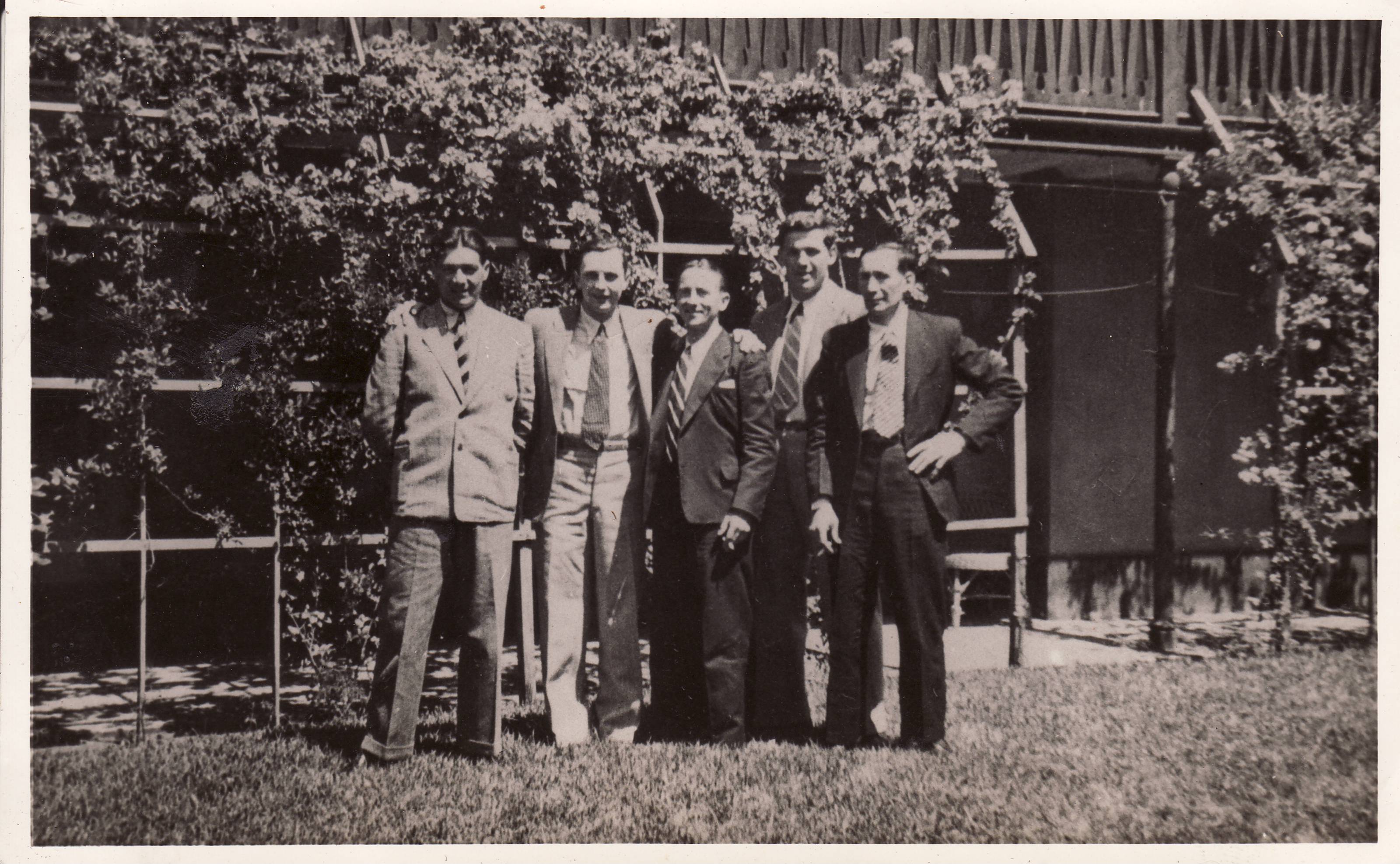
The next aircraft to arrive in Portugal was Wellington X HZ542 during its ferry flight. All of this aircraft's crew would end up on G-AGES, with one loosing his life. The aircraft, assigned to 3 Overseas Aircraft Delivery Unit (3 OADU) was being ferried to North Africa where it would be most likely have been assigned to one of the squadrons using the aircraft in the theatre. P/O L. Kings crew might have gone to the same unit but likewise might have gone to another. It would appear that the crew, listed below, were assigned to 310 Ferry Training Unit of RAF 44 Group, Transport Command. Their escape evasion reports explain that after about 3 and a half hours flying the crew noticed that the fuel consumption was very high and that they would be unable to make their destination or turn back. They decided to make for Portugal and land at an aerodrome south of Oporto. Fog however prevented them doing this and P/O King made an emergency landing at Vergada near Feira seriously damaging the aircraft. They were looked after by the local Portugese Police and stayed the night at a near by military barracks. They were accommodated in Oporto until July 5th, when they were sent for internment in the hotel in Elvas. On July 26th, they in turn were sent by train to Lisbon where the British Air Attaché W/Cdr Schreiber arranged for them to join the ill-fated G-AGES flight the next night. Sadly, Kenneth Devall would lose his life on Mount Brandon that morning. The crew of Wellington HZ542 were:
P/O Leonard King
Sgt. Kenneth J Devall +
Sgt. Victor F E Simmons
Sgt. Roy E Bertram
Sgt. Oliver Frith
Finally, the New Zealander, Sgt. Alfred Brooker Depree would find himself in Portugal on June 17th, having taken off from Portreath in a Spitfire bound for Cairo, via Gibraltar. He was assigned to 543 Squadron which operated reconnaissance equipped Spitfires. Fours hours into his lonely flight, Sgt. Depree had to force land in a field Estremoz in Portugal. He was taken some days later to the Hotel in Elvas and interned. He two travelled to Lisbon on July 26th and joined G-AGES on her last flight. It is uncertain at this time what aircraft he was flying.
Sources:
425 Squadron ORB, The British National Archives (Courtesy of Martin Gleeson)
Escape Evasion Reports Summaries/Reports Ref: WO208-3314 - The British National Archives
MI9/SPG: 1302 - 1306 - 425 Sqd (B L Shaw, R J Lacerte, W J Brislan, F W Wright, L A Defresne)(Courtesy of Martin Gleeson)
MI9/SPG: 1335 310 Ferry Unit (R. E. Bertram)
MI9/SPG: 1399 345 Sqn (A B Depree RNZAF)
MI9/SPG: 1337 310 Ferry Unit (O. Frith)
MI9/SPG: 1334 310 Ferry Unit (L. King)
MI9/SPG: 1369 425 Sqn (L G French RCAF)
Notes from Irish Army Reports SI314 and G2/X/1216
Author not recorded: Early report noted that King was the first man encountered by the military officer when he arrived and he knew the names of Frith, Simmons, Bertram, Dupree and French.
Report by Capt. N. Hewitt, Irish Army G2 Officer from Foynes Dated: 29th July
The nearest transport point was the village of Teel (sic) (Teer). He recognized Max A Roth who was to have flown on to Washington with that days PanAm flight.
Author not recorded: Reported, 30 July 1943, Six (6) people were buried in Killiney Cemetery. Two were identified and four were unknown. 3 were sent for burial in England and 1, Hartigan was sent to Kilmalloch (sic) for burial.
Various name spellings:
Victor Francis Simmins, Simmons
Fred Parr, E G Parr,
Letter by M. O. Loaghaire:
Noted that nine men died at the site and that Mr. Lumby passed away at Tralee Hospital.
Report by Capt. N. Hewitt, Irish Army G2 Officer from Foynes Dated:
He arrived at Mrs. Corkery's Cottage at 12:45. He found the following in the cottage:
R B Lawes, V Rawlinson, J H Slator, R Bertram and upstairs, still conscious in bed, W S Hebden.
In Flaherty's Cottage he found:
Leonard King
He then started up the hill and on the way met E W Vincent being helped down at 13:20.
He then met the following stretcher cases:
Phillips, Parr, Thompson, Oliver Frith, A F R Lumby.
Finally the following were encountered in a group,
Raymond Larche, Alfred Dupree and Gilbert French.
By the time he got to the site at 15:30 all the wounded were removed from the crash site. By 19:15 all the wounded had been cleared from Teer.
Report by Capt. N. Hewitt, Irish Army G2 Officer from Foynes Dated: 1st August
Most of the passengers were RAF airmen including G/Capt. W S Hebden who had started from Cairo. The crew of a crashed bomber had joined them in Lisbon (DB note, King, Bertram and Frith?). Mr. Pullinger was a member of the Royal Engineers. Hewitt writes that newspaper reports were 'substantially correct'. The aircraft was terribly badly burned. No papers of any kind were found on Roth. A list of belongings found included:
A business card holder belonging to Louis Milner.
An artificial leg with shoe and sock.
Report by Capt. N. Hewitt, Irish Army G2 Officer from Foynes Dated: 3rd August
Hewitt reports he was being asked by Lumby's secretary if Mr. Lumby was carrying any official documents at the time.
On July 30th Mr. Liston from the Dept, I & C along with British Airways men, Mr. Brack (London) and Mr. Creane (Foynes) inspected the site.
Dept. of Industry and Commerce issued report on the incident. Reported by Cork Examiner Decemeber 10, 1943.
In the G2 report for another crash, SI/312, a Censor stopped article from the Cork Examiner is noted 27 January 1944 - Joseph (sic) Milner, Johannesburg to be moved to Curraghkippane (Cork) following representations by the Jewish Organization in South Africa.
It also mentioned that it was understood that Menneth (sic) Duval, Dubley, North B'ham was to be brought to England. (DB - It's likely the article author mixed up the first name of Duval with Milner's)
From Swiss Foreign Office (DFAE)
The following information was received from the Swiss Foreign Affair department, Département fédéral des affaires étrangères (DFAE)
Name: Max Albert Roth, Date of Birth: February 15, 1912
Name of the widow: Edith Roth-Douglass
Address: 404 East 55 Street, New York
Mrs Roth was pregnant at the time of the accident, Mr. Roth only had the minimum of insurance- the legal domicile of Mr Roth is not clear and for that reason the widow could not claim a higher pension/compensation for herself and the child.
Max A Roth left Lisbon on July 27th 1943. Place of crash: Foynes, Ireland- Mount Brandon, county of Limerick , July 28th. Airline: British Overseas Airways Corporation.
For the reasons of the crash they stated fog and a careless pilot, who led the machine to deep. The body of Mr. Roth was charred, three of his mail bags destroyed.
British Airways brought the rest of the mail to New York later on. Most of the bodies were irrecognizable.
The bodies of Mr Roth and of two other passengers (no names mentioned) were brought to London by the respective airline and incinerated at the Golden Green cemetery. It was planned to carry over the ashes of Mr Roth to his wife in New York . Most of the other passengers were buried in Ireland in Tralee or near Tralee in Castle-Gregory at the Killiney cemetery, near the place of the crash. Originally it was planned to bury also Mr. Roth and the other two passengers there. But there are no reasons mentioned, why Roth and the others were brought to London by the British Airways.
There are some discrepancies, about which officials joined the funeral in Ireland. Did British and Irish officials join the funeral or only either the ones or the others?
There are a lot of documents, often multiple copies, concerning the claims of Mrs Roth for a higher pension. But it seems, that Mr. Roth did not have any insurance in case of death.
There are a few documents about his life and career before the accident. He wanted to quit the service as a diplomatic courier, because it was a stressful work with a low salary.
Mr Roth was born in St. Gallen, a small town in the eastern part of Switzerland . The names of his parents were: Albert and Berta Roth.
Max A. Roth grew up in St. Gallen and finished the school of hotel management in Lucerne. He worked in several jobs in this area, before he became a courier.
There are two photos of him the document. No brothers and sisters are mentioned.
He was incinerated in Golden Green, but his body was planned to be carried to New York (at the instigation of the director of British Airways). Maybe, the bodies of the two other passengers are buried in London? Unfortunately I didn’t find more details about them. Roth was incinerated in London in attendance of Mr. Barbey and some representatives of the British Airways.
The pension of his wife was 3000-3500 francs a year, that means about 250.- per month. This was the pension the “state insurance” (Eidgenössische Versicherungskasse) paid, if a courier died while doing his job. There are references in the documents, that the case of Mr. Roth and his poor widow was a reason for further discussions on higher pensions in such cases, but the informations are not detailed enough to confirm this. As the child was not born at the time of the accident, there is no name mentioned in the documents. But maybe, you can find out more, through the address of the widow in New York. She was originally American, so presumably she continued living in New York or the States.
Promotions notes for RAF officers from London Gazette
Gazette Issue 34778 published on the 23 January 1940. Page 5 of 56
Royal Air Force Volunteer Reserve.
GENERAL DUTIES BRANCH.
The undermentioned are granted commission for the duration of hostilities in the ranks' and on the dates stated: —
Pilot Officers.
9th Dec. 1939.
561531 Sergeant Thomas ALLITT (77029).
Gazette Issue 34810 published on the 12 March 1940. Page 11 of 64
In the Gazette of 23rd Jan. 1940. For
561531 Sergeant Thgmas ALLITT read 561440
Sergeant Thomas ALLITT.
Gazette Issue 35028 published on the 31 December 1940. Page 6 of 34
The undermentioned Pilot Officers are promoted
to the rank of Flying Officer.
9th Dec. 1940.
Thomas ALLITT (77029).
Gazette Issue 35444 published on the 3 February 1942. Page 11 of 44
Flg. Offs. to be Flt. Lts. (war subs.): —
T. ALLITT (77029). gth Dec. 1941.
Gazette Issue 37249 published on the 31 August 1945. Page 2 of 6
RESERVE OF AIR FORCE OFFICERS.
ADMINISTRATIVE AND SPECIAL DUTIES BRANCH.
Appointment to commission.
As Pit. Offs. (class CC): —
Ralph Bousquet LAWES. 11th July 1945.
Gazette Issue 36389 published on the 18 February 1944. Page 4 of 1
ROYAL AIR FORCE VOLUNTEER RESERVE.
GENERAL. DUTIES BRANCH. ,.
Appointment to commission.
As Pit. Offs. on prob. (emergency}'.—
Flt Sgts
18th Jan. 1944.
909163 Eric William VINCENT (170393).
Gazette Issue 39386 published on the 16 November 1951. Page 7 of 10
ROYAL AIR FORCE RESERVE OF OFFICERS.
GENERAL DUTIES BRANCH.
Appointment to commission (class CC).
As Flying Officers: —
5th July 1951
Eric William VINCENT (170393).
Gazette Issue 39861 published on the 22 May 1953. Page 3 of 6
ROYAL AIR FORCE RESERVE OF OFFICERS.
GENERAL DUTIES BRANCH.
Commission relinquished (class CC).
The undermentioned (on cessation of duty): —
Flying Officers:—
18th Mar. 1953.
E. W. VINCENT (170393).
Gazette Issue 36957 published on the 23 February 1945. Page 2 of 8
ROYAL AIR FORCE VOLUNTEER RESERVE.
GENERAL DUTIES BRANCH.
Appointment . to. commission.
As Pit. Offs. on prob. (emergency): —
1606485 Roy Elliott BERTRAM (190225). 22nd Nov. 1944. ???
Gazette Issue 39275 published on the 29 June 1951. Page 3 of 6
SECRETARIAL BRANCH.
Appointment to commission.
Promotion.
Flying Officer to Flight Lieutenant: —
7th June 1951.
R. E. BERTRAM (190225).
Gazette Issue 40061 published on the 29 December 1953. Page 7 of 12
SECRETARIAL BRANCH.
Appointment to commission (permanent).
As Flight Lieutenant:—
Roy Elliott BERTRAM (190225). 1st Oct. 1953.
Gazette Issue 45718 published on the 3 July 1972. Page 9 of 12
SECRETARIAL BRANCH
Squadron Leader to Wing Commander :
R. E. BERTRAM, A.M.B.I.M. (190225).
Gazette Issue 46786 published on the 5 January 1976
Retirement
Wing Commander R. E. BERTRAM, A.M.B.I.M. (190225)
(at own request), 1st Jan. 1976.
Gazette Issue 35949 published on the 19 March 1943. Page 3 of 8
ROYAL AIR FORCE VOLUNTEER RESERVE.
GENERAL DUTIES BRANCH.
To be Pit.. Offs. on prob. (emergency): —
Wt. Offs.
754948 Leonard KING (139574). 1st Nov. 1942.
Gazette Issue 39745 published on the 2 January 1953. Page 6 of 8
ROYAL AIR FORCE VOLUNTEER RESERVE.
(Emergency commission section.)
General Duties Branch
Removal.
Flying Officer L. KING (139574). 29th Sept. 1952.
Gazette Issue 36923 published on the 2 February 1945. Page 2 of 8
ROYAL AIR FORCE VOLUNTEER RESERVE.
GENERAL DUTIES BRANCH.
Appointment to commission.
As Pit. Offs. on prob. (emergency): —
Wt. Offs.
1319140 Oliver FRITH (189558). 28th Oct. 1944.
Second Lieutenants to be Second Lieutenants,
with promotion to Lieutenant from the date
specified.
FROM THE UNATTACHED LIST.
Arthur Friedrich Rawson Lumby, 69th Punjabis.
Dated 5th October, 1913, with rank
as Lieutenant from 5th December, 1913.
Gazette Issue 34553 published on the 20 September 1938. Page 3 of 56
ROYAL ENGINEERS.
The undermentioned 2nd Lts. to be
Lts.:—
14th Aug. 1938.
S. L. Pullinger.
Gazette Issue 36095 published on the 13 July 1943. Page 2 of 6
REGULAR ARMY RESERVE OF OFFICERS.
REGIMENTAL LIST.
CORPS OF ROYAL ENGINEERS.
The undermentioned from Supp. Res. in rank as stated retaining their present .seniority: —
Lts.: —
20th Oct. 1940: —
(War Subs. Capt.) S. L. Pullinger (65857).
Gazette Issue 34318 published on the 28 August 1936. Page 4 of 64
The undermentioned Gentlemen Cadets,
from the Royal Military Academy, to be 2nd
Lts. 27th Aug. 1936:—
ROYAL REGIMENT OF ARTILLERY.
Diarmuid John HARTIGAN.
Air Ministry,
8th March, 1938.
ROYAL AIR FORCE.
GENERAL DUTIES BRANCH.
The undermentioned Airman Pilots are granted commissions as Pilot Officers on probation with effect from 24th Feb. 1938: —
365595 Flight Sergeant David William STANNARD.
Gazette Issue 35791 published on the 17 November 1942. Page 4 of 22
Flt. Lts. (tempy. or war subs. Sqn. Ldrs.) to
be Sqn. Ldrs.: —
1st Dec. 1941.
D. W. STANNARD (36119).
Other wartime fatalities in the Mount Brandon area.
It is perhaps fitting here to remember the crews of the other two aircraft which suffered fatalities on the slopes of Sleiveglass during the 1943.
August 22nd 1943, Short S.25 Sunderland III DD848, 201 Squadron RAF
F/O Guy Nelson Wilkinson 51121 +
F/Lt Charles Seymour Grossey 45199 +
F/Lt Arthur Charles Griffin 62311 +
F/Sgt Norman Baron Pickford 657043 +
F/Sgt Joseph William Burton 1287499 +
F/Sgt John Robert Coster 1259732 +
F/Sgt Walter Noel Pitts 749904 +
Sgt George Frederick Walter Tilt 1338702 +
(Three Survivors)
Sgt John Sidney Applegate 647007
Sgt George William Davies 952226
F/Sgt William Mclean 996639
See webpage on this crew: dd848.htm
December 20th 1943, Vickers Wellington XVI HF208, 304 (Polish) Squadron
F/Sgt Klemens Adamowicz + 780537
Sgt Stanisław Czerniawski + 794362
Sgt Naftali Hirsz Kuflik + 794712
Sgt Paveł Kowalewicz + 703968
Sgt Kazimierz Ługowski + 703438
Sgt Wincenty Pietrzak + 782657
To advise new information, corrections or for further details please contact:
Dennis Burke. 2018
Cloonacool, Tubbercurry, Co. Sligo, Ireland
dp_burke@yahoo.com or irishwarcrash@yahoo.com
The gentleman at the following Flickr album has completed a model of G-AGES from a partially complete kit that he purchased. It must be said it looks fabulous.


